Caligula’s Pleasure Ships of Lake Nemi
Two thousand years ago, the debauched Roman emperor Caligula ordered the construction of two large floating pleasure barges on the relatively small Lake Nemi so that he could indulge in many of the depravities attributed to him. Lake Nemi is a small, shallow crater lake in the Alban Hills, approximately 30 km southeast of Rome, that has long been a vacation getaway for Romans, and now Italians, from the intense summer heat. Emperor Caligula, like his predecessor Emperor Tiberius, liked to spend his summers sailing in Lake Nemi.
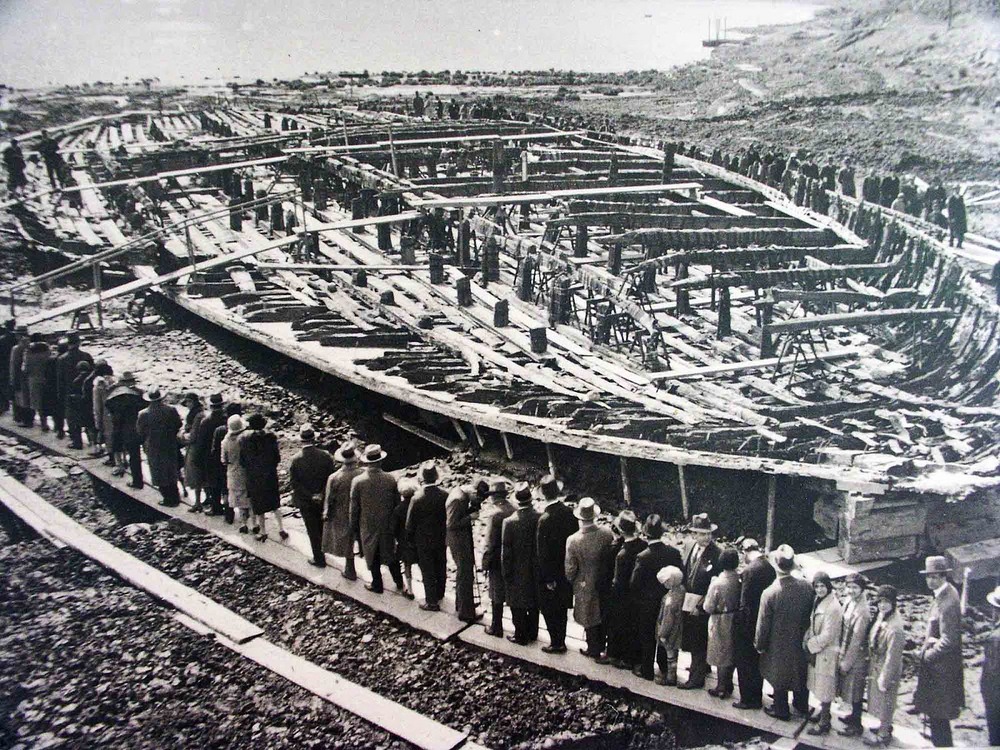
Caligula ordered two large ships, more than 70 meters long, which he intended to use during his vacations. One ship was a floating temple dedicated to the goddess Diana. The other was a floating pleasure palace. Both ships were of nearly identical size, with one slightly larger than the other. The larger one was dubbed prima nave (first ship), and the smaller was called seconda nave (second ship).
The ships were meant to be anchored in place, and therefore had no means of propulsion such as sails, although they did have large rowing stations with long oars that was used to steer the ships. The ships had large marble palaces ostensibly decorated with mosaics, gemstones, statues, marble paving stones, gilded copper roof tiles, and fruit gardens. The palaces were equipped with plumbing and had hot water delivered to the baths through lead pipes.
Despite the immense cost at which they were constructed, these opulent palaces were afloat only for a brief time, most likely a year or two, before Caligula’s four year reign came to an end. He was assassinated by an alliance of Praetorian Guard, senators, and courtiers in 41 AD. Shortly after his death, the ships were sunk intentionally. They settled in shallow water at a depth of about 20 meters, a short distance away from the shore area where they were built and docked.
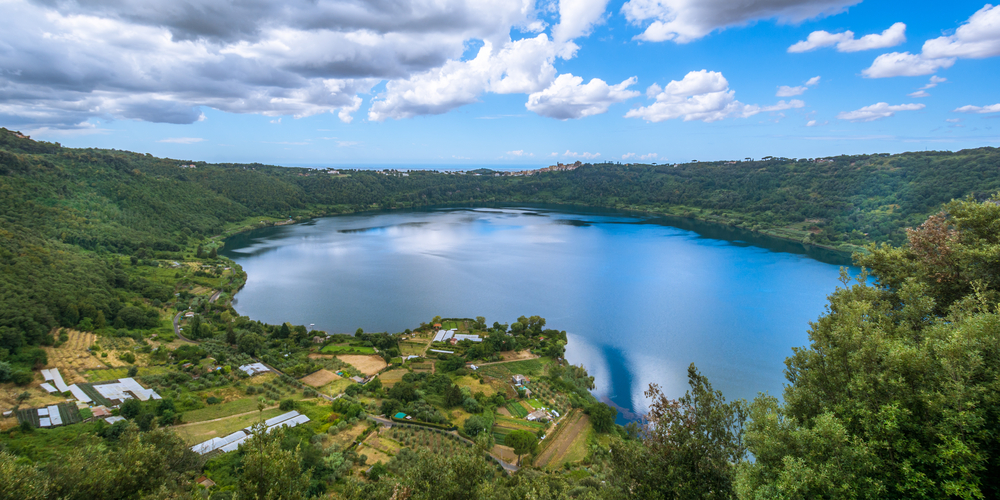
Lake Nemi. Image credit: Stefano_Valeri/Shutterstock.com
Caligula’s ships were gone, but not forgotten. Throughout the medieval period, local fishermen used grappling hooks to pull up pieces of the ship and small artifacts which they sold to tourists. The first attempt to recover the ships was commissioned by Pope Prospero Colonna in the mid-1400s. A floating platform was made and expert divers brought from Genoa were sent down to the bottom. But the ships were too massive to the brought to the surface. All they managed was to tear off some planks. The second attempt took place in 1535 under the direction of Francesco De Marchi. He personally plunged into the lake using a diving bell, and recovered many items of marble, bronze, copper and lead. The timber beams he carved into walking sticks and boxes. It would need another four hundred years and the audacity of a fascist dictator to uncover the ships.
In 1928, Benito Mussolini ordered the whole of Lake Nemi to be drained so that the ships could be recovered. Engineers reactivated an ancient Roman underground water conduit linking the lake to farms outside the crater and began pumping water. Five months later, the first ship broke the surface. Two years later, the second ship was exposed. By this time over 40 million cubic meters of water was removed from the lake, and its level had dropped more than 20 meters. Then something curious happened. The lake bed, released of this enormous weight, began to bounce up and erupted in mud flows. This caused the lake floor to subside threatening the exposed ships. Work was suspended for almost a year. The second attempt at draining the lake was successful, and both ships were freed from the mud and carefully transported to dry land, where a museum was built to house them. The museum was inaugurated in 1936.
On the night of May 31 1944, less than four years after Italy entered the Second World War, the museum along with both ships was razed to the ground. It is not known whether the fires were started because of US bombing or German arson. Both parties blame the other. The ships were almost totally destroyed. Only some bronzes and materials that were already moved to museums in Rome survived.
Today, only scaled replicas of the ships exist at the museum.
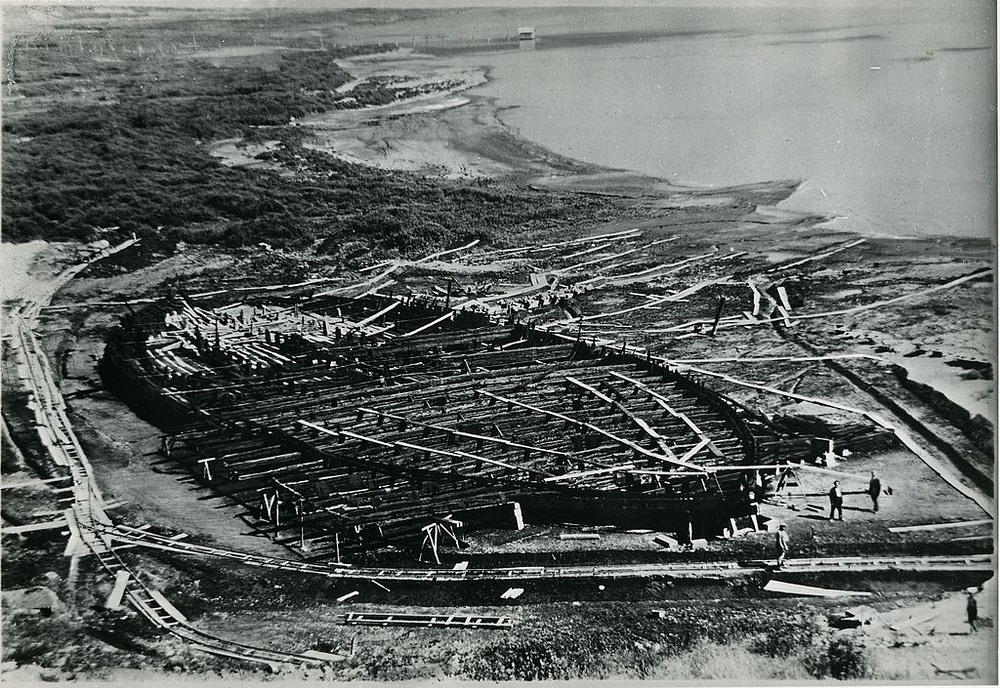
Benito Mussolini attends the inauguration of the museum housing the Nemi ships.


More on Amusing Planet
{{posts[0].title}}
{{posts[1].title}}
{{posts[2].title}}
{{posts[3].title}}

Advertisement
Featured articles, top countries.

Ready to Cook Featherless Chicken

The Osoaviakhim-1 Disaster

Devon Island: Mars on Earth

Elephant Foot Glacier

The Wave Swept Lighthouses of Brittany, France

Dhunge Dhara: Nepal’s 1,600-Year-Old Drinking Water Fountains

Horizontal Collaboration: Sleeping With The Enemy
Congreve Rolling Ball Clock

Watch 1505: The World's First Watch

City Crows Build Nests Out of Coat Hangers
- The Magazine
- Stay Curious
- The Sciences
- Environment
- Planet Earth
Nemi Ships: How Caligula's Floating Pleasure Palaces Were Found and Lost Again
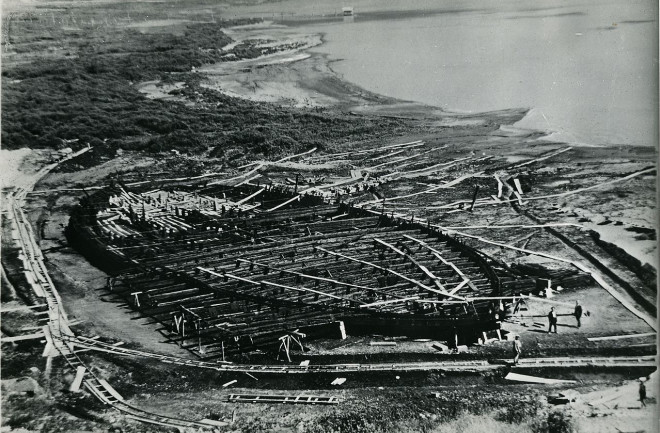
For centuries, the medieval fishermen who sailed in the placid waters of Lake Nemi, 19 miles south of Rome, knew a secret. It was said that the rotting timbers of a gigantic ancient shipwreck lurked below the water’s quiet surface. But the lake was tiny, with an area of only 0.6 square miles. And with no other body of water connected to it, what could a vessel of that size be doing there? Still, the stories about the gigantic ship persisted.
They couldn’t have known then, but at the bottom of this tiny lake were two of the most unique artifacts ever to be uncovered from the ancient world. Their story would span millennia, bridging the eccentricities of Rome’s most notorious Emperor and one of the twentieth century’s most reviled rulers — only to be lost forever in the fires of war.
Leviathans in the Deep
Looking at the placid waters of Lake Nemi in the 15th century, none of that would have seemed plausible. But for years now, fishermen had been using grappling hooks to bring up ancient artifacts from the legendary wreck that lay beneath, and selling them in the markets. An investigation was warranted.
In 1446, a young Cardinal and nephew of the Pope named Prospero Colonna, decided to probe for himself the rumours of an unlikely shipwreck at the bottom of Lake Nemi. He sailed out onto the lake, and sure enough, he could just make out a sprawling lattice of wooden beams. He and his men tried to send down ropes with hooks on the end to retrieve parts of this mysterious structure, but at a depth of 60 feet they didn’t have much luck. All they managed was to tear off some planks. Colonna had confirmed that the wreck existed, but from there the mystery only deepened.
Lake Nemi today. (Credit: Wikimedia Commons)
In 1535, Italian inventor Guglielmo de Lorena and his partner Francesco de Marchi returned to the wrecks with a new and exciting technology: a diving bell. They descended through the murk and gloom and saw an enormous wooden superstructure far vaster than anything they had imagined. The two fished around in the lake bottom for artifacts, and managed to bring up sculptures made of marble and bronze scattered on the muddy lake bottom. Many others tried to explore and survey the wrecks, but without much success. It wasn’t until Italy fell under the sway of the fascist dictator Benito Mussolini that the ships would finally be uncovered.
A Dictator Obsessed
Mussolini was a man obsessed with the legacy of Imperial Rome, and he worked hard to include its archaeological remains in his cult of personality. Mussolini had embarked on ambitious projects around the capita:, Excavating the mausoleum of Augustus to build a Fascist piazza around it, clearing the buildings that clustered around the Theatre of Marcellus and digging up the floor of the Colosseum’s Arena to expose the hypogeum beneath and stripping it of its once verdant plant life. He was frequently described in propaganda dispatches as “a new Augustus”, evoking the Roman Emperor who rebuilt much of the city during his reign.
It was only a matter of time, then, before the dictator’s attention turned to the mysterious ships at the bottom of Lake Nemi. In 1929, Mussolini ordered something unprecedented. The whole of Lake Nemi would be drained. Engineers reactivated an ancient Roman cistern that together with a modern pump reduced the lake’s water level by 65 feet. In the mud, slowly emerging from the waters, the Italian engineers found not one, but two enormous shipwrecks. The excavations would take years, with the second ship not brought up until 1932.
The ships were vast, among the largest ever recovered from the ancient world. The largest was 240 feet in length, the same length as an Airbus A380, and measured 79 feet across. From inscriptions on lead pipes and tiles, it soon became clear that what had been discovered were the floating pleasure palaces of the infamous first century Roman Emperor Caligula.
The larger of the two Nemi pleasure palaces. (Credit: Wikimedia Commons)
From One Emperor to Another
Caligula was Emperor for only four years, from 37-41 CE, but his name has lived on in history due to a penchant for sadism, hedonistic excess and brutality. He demanded to be worshipped as a living God, and had the expensive tastes to match. Records show that he emptied the Imperial treasury in a single year with extravagant games and spectacles.
It seems Caligula may have built his ships on the tiny Lake Nemi due to its alignment with the goddess Diana Nemorensis, a fitting place for a living divinity to site his pleasure barges. Here, Caligula had two ships built at enormous expense. The largest, dubbed the “prima nave” (first ship) was an enormous vessel, steered with oars 36 feet long. The second was a giant floating platform replete with marble palaces, gardens, and a system of plumbing for baths. Roman historian Seutonius described the sight of the ships: “Ten banks of oars… the poops of which blazed with jewels… filled with ample baths, galleries, and saloons, and supplied with a great variety of vines and fruit trees.”
On these ships, Caligula was reported to hold parties where his wild and licentious appetites ran wild, with later historians repeating scurrilous and outlandish rumours about relationships with the wives of his generals and senators, and even with his own sisters.
A man poses with one of the Nemi ships. (Credit: Archivio fotografico storico del Museo della scienza e della tecnologia L. da Vinci/Wikimedia Commons)
Until the discovery of the Nemi pleasure barges, it was thought that the Romans were incapable of building such large vessels. Historians had assumed that measurements of up to 164 feet given for grain-carrying vessels in some ancient sources were exaggerations. The Nemi ships show they may have been real. While excavating at Lake Nemi, Italian archaeologists uncovered a veritable treasure trove of artifacts from the wrecks. Vast anchors, bronze mouldings and marble statues came up from the depths, along with ornamental oar rings and joints in copper and bronze. They found carvings and mosaics, even gilded copper roof tiles that would have shone spectacularly in the sun. The expense of the vessels would have been enormous.
Bronze oar rings recovered from the pleasure barges. (Credit: Folegandros/Wikimedia Commons)
The wooden beams of the ships were even coated with lead, a costly treatment designed to protect sea-going vessels from shipworms. Here this treatment was useless, since shipworms don’t live in fresh water. Despite their expense, these opulent palaces were afloat for only the briefest time. It seems they were only in use for about a year before Caligula’s four year reign came to an end. An alliance of senators and the Praetorian Guard ambushed him in a tunnel beneath Rome’s Capitoline Hill and stabbed him to death. Attempts to restore the Republic after Caligula’s death failed. The Roman military ignored the senate and reinstated Imperial monarchy. Caligula’s floating palaces, too, went the way of their creator. Their hulls pierced, the immense ships were weighted with stones and sunk to the lake bottom.
Pride and the Fall
For Mussolini, the recovery of the ships had been a significant triumph. As the mud-soaked wrecks rose out of lake Nemi, it seemed a good metaphor for his promises to revive the legacy of ancient Rome in the modern day. He had a huge museum built in 1936 to house the wrecks, so that the public could visit. But Mussolini, like Caligula, would soon face a fitting downfall. And the Nemi ships would follow him into the ashes of history.
Mussolini at the dedication of the museum housing the Nemi ships, 1940. (Credit: Wikimedia Commons)
On the night of May 31 1944, less than four years since Mussolini entered the Second World War in support of Hitler’s Germany, Italy was on the brink of defeat. The country had nearly capitulated, and had been invaded by the Nazis to prevent their resistance from collapsing. But the Germans were on a multi-front retreat across all of Europe. Allied troops were closing in.
It’s not known whether the fires started as a result of US artillery or German arson. Nazi troops frequently set fire to positions they abandoned, blowing up bridges on the retreat and doing anything they could to slow the advance of the Allies. Either way, the Nemi ships burned. Only some bronzes survived, along with a handful of photographs of the colossal wrecks. Like Caligula, Mussolini met an ignoble end. Less than a year after the ships burned, he was shot while fleeing Italy in disguise. Two days later, Hitler followed by shooting himself.
Today, the ghosts of the Nemi ships live only in their photographs, and the few remaining artifacts that survived the fire. They form a haunting parable for those who would use the remains of the past for their own ends, while taking no heed of their warnings.
- archaeology
Already a subscriber?
Register or Log In

Keep reading for as low as $1.99!
Sign up for our weekly science updates.
Save up to 40% off the cover price when you subscribe to Discover magazine.
Italians viewing antique Emperor Caligula's Nemi ships, 1932

After nearly 1,900 years at the bottom of Lake Nemi, the ships became visible again.
Between 1928 and 1932, two enormous wooden ships, which once belonged to Emperor Caligula, and had lain on the bottom of the Lake Nemi for over nineteen hundred years, were salvaged in what was perhaps the greatest underwater archaeological recovery ever accomplished.
The larger ship was essentially an elaborate floating palace, which contained quantities of marble, mosaic floors, heating, and plumbing such as baths among its amenities. Both ships featured technology long thought to be recent inventions.
One of the most fascinating aspects of the whole affair was the fact that knowledge of the two huge vessels being in the lake had never been lost throughout the ages, from the reign of Caligula to the twentieth century. There were several attempts at salvage carried out at various times, most of which resulted in the degradation of the wrecks and plundering of artifacts.
Lake Nemi is a place of great scenic beauty. It is formed by the crater of an old volcano and the name is derived from the Latin word for a grove. It has a surface of 1.67 km2 (0.64 sq mi) and a maximum depth of 33 meters (108 ft).
Throughout history, various deities have been venerated there. The area is principally associated with the goddess Diana and the lake was known in antiquity as the Speculum Dianae or “The Mirror Of Diana”.
There is considerable speculation regarding why the emperor Caligula chose to build two large ships on such a small lake. From the size of the ships it was long held that they were pleasure barges, though, as the lake was sacred, no ship could sail on it under Roman law implying a religious exemption.
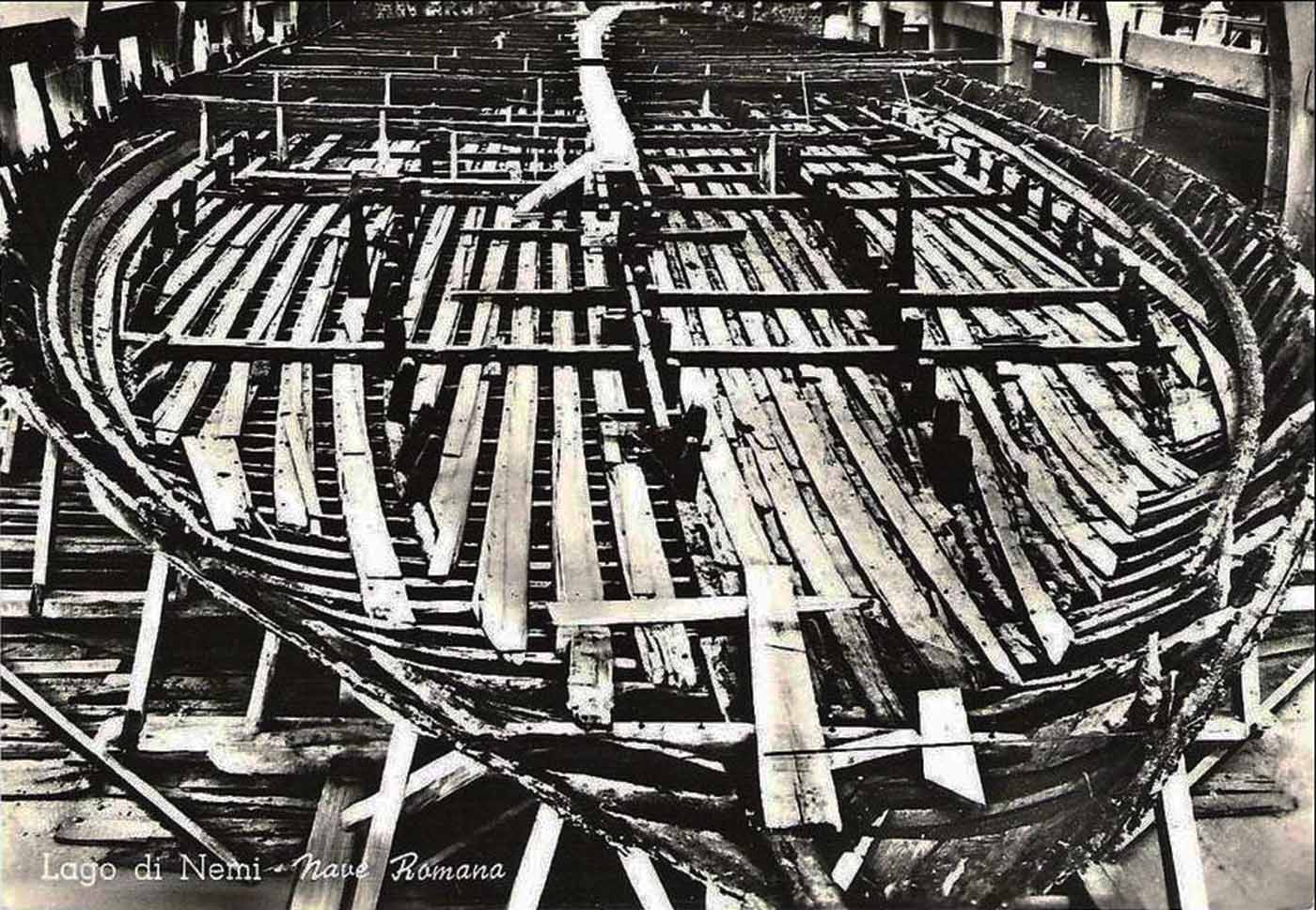
Local fishermen had always been aware of the existence of the wrecks, and had explored them and removed small artifacts, often using grappling hooks to pull up pieces, which they sold to tourists.
As one of his royal passions, Emperor Caligula ordered several large barges to be built to use on Lake Nemi. The two vessels, which were designated in modern times as Prima Nave and Seconda Nave , (First Ship and Second Ship), had dimensions of 70m x 20m (230ft x 66ft) and 73m x 24m (240ft x 79ft) respectively.
While there can be little doubt that the ships were built at the capricious whim of a spendthrift despot, their intended purpose and eventual use have long been the subject of debate by scholars and historians. Some contend that Caligula built the barges to show the rulers of Syracuse, Sicily, and the Ptolemaic rulers in Egypt that Rome could match any luxurious pleasure barges that they built.
Other scholars argue that Caligula designed one of his ships as a floating temple to Diana and some say that the other ship may have been used as a floating palace where Caligula and his court could indulge in the depravities that history has credited to him.
Seutonius, the Roman historian described the two biggest barges as being built of cedar wood adorned with jeweled prows, rich sculpture, vessels of gold and silver, sails of purple silk, and bathrooms of alabaster and bronze. The floors were paved with glass mosaic, the windows and door frames were made of bronze, and many of the decorations were priceless.
The Romans made ball bearings out of the lead and they probably used the ball bearings on the Nemi ships to make the statues of the gods rotate or to move the windlasses. The flat-bottomed Nemi barges were not self-propelled.
Instead, they were attached to the shore by chains and bridges stretching across the water so people and commerce could travel back and forth. According to some historical accounts, Caligula’s ships were the scenes of orgies, murder, cruelty, music, and sport.

Some contend that Caligula built the barges to show the rulers of Syracuse, Sicily, and the Ptolemaic rulers in Egypt that Rome could match any luxurious pleasure barges that they built.
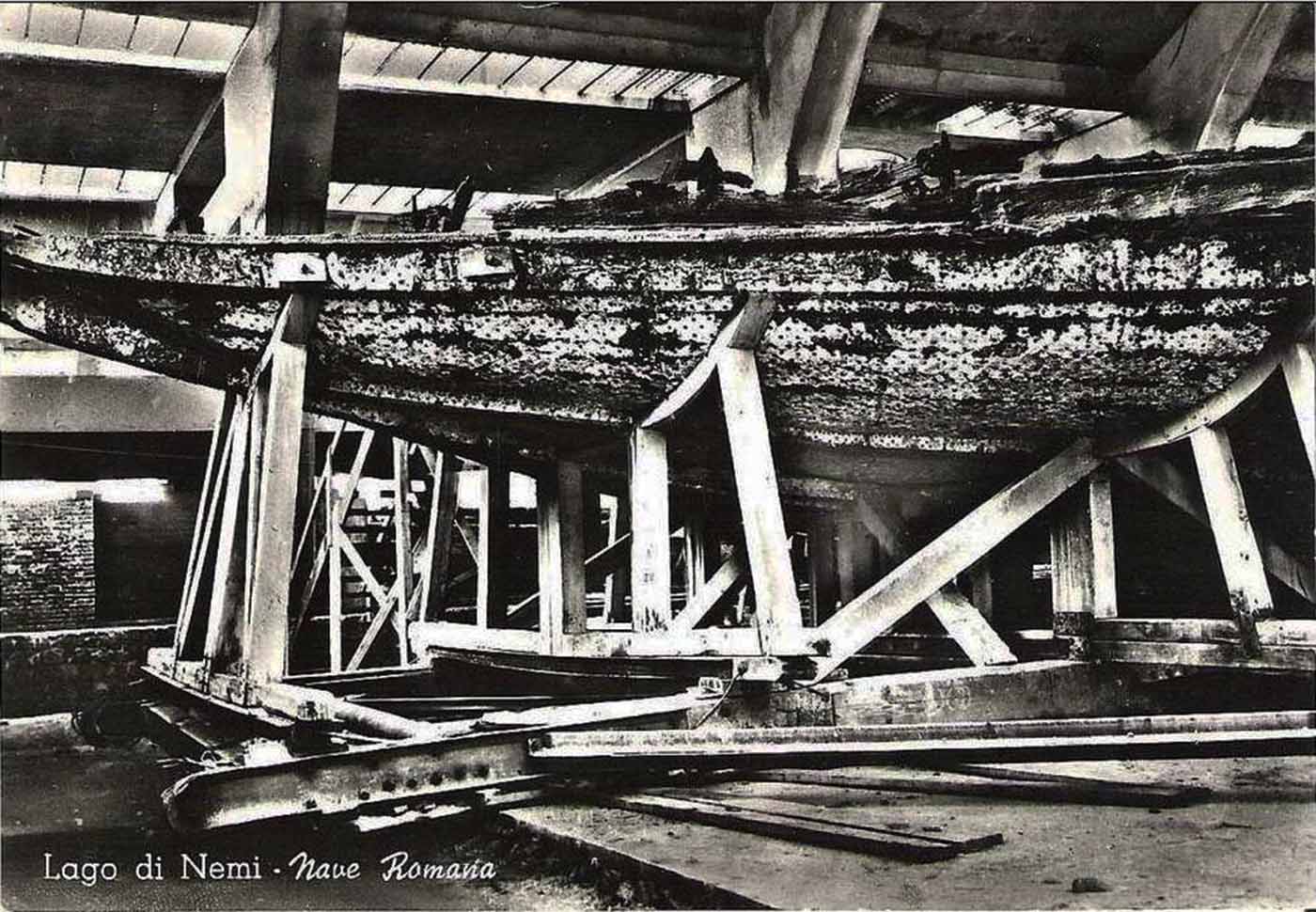
The two vessels, which were designated in modern times as Prima Nave and Seconda Nave, (First Ship and Second Ship), had dimensions of 67m x 19m and 71m x 24m respectively.
In 1446, Cardinal Prospero Colonna and Leon Battista Alberti followed up on the stories regarding the remains and discovered them lying at a depth of 18.3 meters (60ft), which at that time was too deep for effective salvage. They caused significant damage to the ships by using ropes with hooks to tear planks from them.
The Fascist government of Benito Mussolini worked to recover Caligula’s ships for about five years – from October 1928 to October 1932. Mussolini ordered antiquarian Guido Ucelli, the Italian Navy, engineers of Civil Engineers, industry, private individuals, and archaeologists to drain Lake Nemi.
The local people and archaeologists knew of an ancient Roman underground tunnel that connected the lake to farms outside the crater and they connected it to a floating pumping platform. Using powerful pumps and water scooping machines, the workers lowered the level of the lake and by June 10, 1931, they had recovered the first ship and the second had been exposed.
By this time the water level had dropped more than 20 meters (66ft) with over 40 million cubic meters of water removed. A London Times story reported that everyone on the site cheered as the waters receded to reveal the first Nemi ship. After nearly 1,900 years at the bottom of Lake Nemi, the ships again rode the waves.
The devastation caused by previous attempts at lifting was all too apparent from the time the ship became visible. Practically all of the original upper-works had been torn off and what remained lay in a jumble inside the hull with a multitude of other artifacts.

Benito Mussolini attending the inauguration of Museum of Nemi (Il Museo delle Navi Romane).
The ships were destroyed by fire in World War II on the night of May 31, 1944. Several US army shells hit the Lake Nemi Museum around 8 pm, causing little damage but forcing the German artillery to leave the area. Then a few hours later, smoke arose from the Museum and soon the two ships were burnt to ashes although the museum’s concrete structure suffered little damage.
The Lake Nemi Museum was restored and reopened in 1953. Photographs, drawings from the Italian Navy survey, and drawings of archaeologist G. Gatti also survived the fire, allowing artists and architects to make reconstructions of the two ships.
The spaces that once held the two immense Nemi Ships are now filled by one-fifth scale models built in the naval dockyard near Naples, and bronzes and other artifacts that survived the fire. Outside the Lake Nemi Museum, a life-size reconstruction of the sailing ship’s hull is displayed.
Emperor Caligula’s Nemi ships
By 1827, interest had revived to recover Caligula’s ships. Annesio Fusconi built a floating platform from which to raise the wrecks however, several of his cables broke so he called a halt until he could find stronger cables. When he returned, he found that the locals had dismantled his platform to make wine barrels leading to him abandoning the project.
The discovery proved that the Romans were capable of building large ships. Before the recovery of the Nemi ships, scholars often ridiculed the idea that the Romans were capable of building a ship as big as some ancient sources reported the Roman grain carriers were. Piston pumps supplied the two ships with hot and cold running water via lead pipes.
The hot water supplied baths while the cold operated fountains and supplied drinking water. This plumbing technology was later lost and only re-discovered in the Middle Ages.
The emperor Caligula had a very brief reign. He ruled from 37A.D. to 41A.D. for a period of three years and ten months. He is generally depicted by historians as a cruel megalomaniac who was noted for many excesses, not the least of which was his ability to squander, in a year, the entire resources of the Imperial treasury that had been built up by his predecessor Tiberius, on extravagant but useless schemes.
Caligula’s brief reign came to an abrupt end when he was assassinated by members of the Praetorian Guard, who were sickened by his depraved behavior and reckless expenditure. He was twenty-eight years of age.
Updated on: November 25, 2021
Any factual error or typo? Let us know.

- Ancient History
- Archaeology
The Truth of Caligula’s Wild Ship Party Uncovered
The emperor Caligula is infamous for a whole host of reasons. According to the ancient sources, when he wasn’t busy shagging his three sisters or arbitrarily murdering anyone who posed him the slightest of threat, he would pass his time making the lives of Rome’s senatorial elite a living nightmare, demanding to be worshipped as a god or leading the Roman state or the Roman army on a series of vainglorious (and ultimately fruitless) pursuits. But aside from his more notorious proclivities, what’s less well known is that Caligula was an enthusiastic shipbuilder.
Caligula’s second century AD biographer, Suetonius, has left us a colorful description of some magnificent galleys the emperor once built along the beautiful coastline of Campania (the southern Italian region that has Naples as its capital):
He had constructed some Liburnian galleys, their prows studded with jewels, their sails of many colors, whose ample interiors housed baths, porticoes, and dining-rooms as well as a large variety of vines and fruit-trees so that lounging on these vessels he might travel by day along the shores of Campania entertained by choirs and orchestras.

Although we’re constantly discovering Roman shipwrecks, some dating as back as the First Punic War against Carthage (264 – 241 BC), we’ve yet to locate the ships Suetonius mentions. In all likelihood, they, like the vast majority of relics from the ancient world, have been lost to the processes of erosion, degradation, and the passing of time. However, although a lot of what Suetonius writes about Caligula is historically debatable, we know that he was telling the truth about the emperor’s nautical endeavors because we’ve discovered two—soon to be three—other ships the emperor built.
The site of the ships’ discovery, Lake Nemi, lies 19 miles south of Rome in the region of Lazio. The lake’s name, Nemi, comes from the Latin word nemus , meaning “holy wood”. It’s easy to see how this description might have come about. Lake Nemi is a place of astounding natural beauty: situated some 300 metres above sea level, the lake was formed within an extinct volcanic crater. Its stunning scenery wasn’t lost on past commentators. Lord Byron wrote of, “Nemi, navelled in the woody hills”, while artists from Turner to Jean Charles Joseph used the lake as the backdrop for their dramatic landscapes (pictured below).
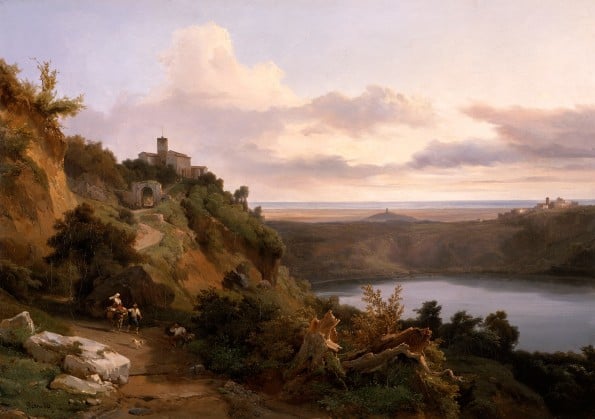
Today, Nemi is famous mainly for its distinctively small and sweet strawberries. Throughout history, however, Nemi has been famous across Italy and abroad as the resting place of Caligula’s colossal pleasure barges (known as the Nemi Ships). It’s incredible that Caligula thought to build these 220 and 230 feet long floating orgy palaces on Lake Nemi, considering it only has a circumference of 3.5 miles. It’s even more incredible that, since the emperor’s assassination at the hands of his Praetorian Guard in 41 AD, the area’s inhabitants never lost the knowledge that two of these ships lay sunken at the bottom of the lake’s western side.
NEXT >>

Salvaging the Nemi Ships
There was no shortage of attempts to salvage the Nemi Ships over the centuries. Most, however, did far more harm than good. The first salvage effort came about in the mid-fifteenth century when the Lord of Nemi, Cardinal Prospero Colonna, commissioned the renowned architect Leon Battista (the designer of Rome’s original Trevi Fountain) to devise a way of pulling them up from the lakebed. Battista’s response was to construct an enormous raft, complete with ropes, pulleys, and grappling hooks which divers would attach to the ships’ hulls, and sail it out into the middle of the lake.
His efforts, however, were in vain. Though the hooks managed to get purchase of the ancient ships, they were unable to dislodge them from the lakebed’s muddy grip. They succeeded only in tearing off the ships’ lead water pipes and various fragments of wood from the beaten and bruised vessels. It wasn’t all for nothing though: classical enthusiasts were at least impressed by the quality of the woodwork. Subsequent attempts were more or less to follow this example (and share in its success) until 1895, when Signor Borghi obtained permission from Nemi’s landowner, Prince Orsini, to head up another expedition.
With his team of divers, Borghi brought to the surface numerous bronze works that decorated the ships’ hulls. In addition to more lead piping and gilded bronze roof tiles, Borghi managed to salvage a bronze lion’s head (pictured above); one of many remarkable decorative artworks used to hold the ship’s mighty oars in place. While Borghi’s efforts may have born fruit, it also marked a temporary halt to salvage attempts at Nemi, not least because authorities were becoming increasingly concerned that the Nemi Ships were several expeditions away from completely disintegrating.
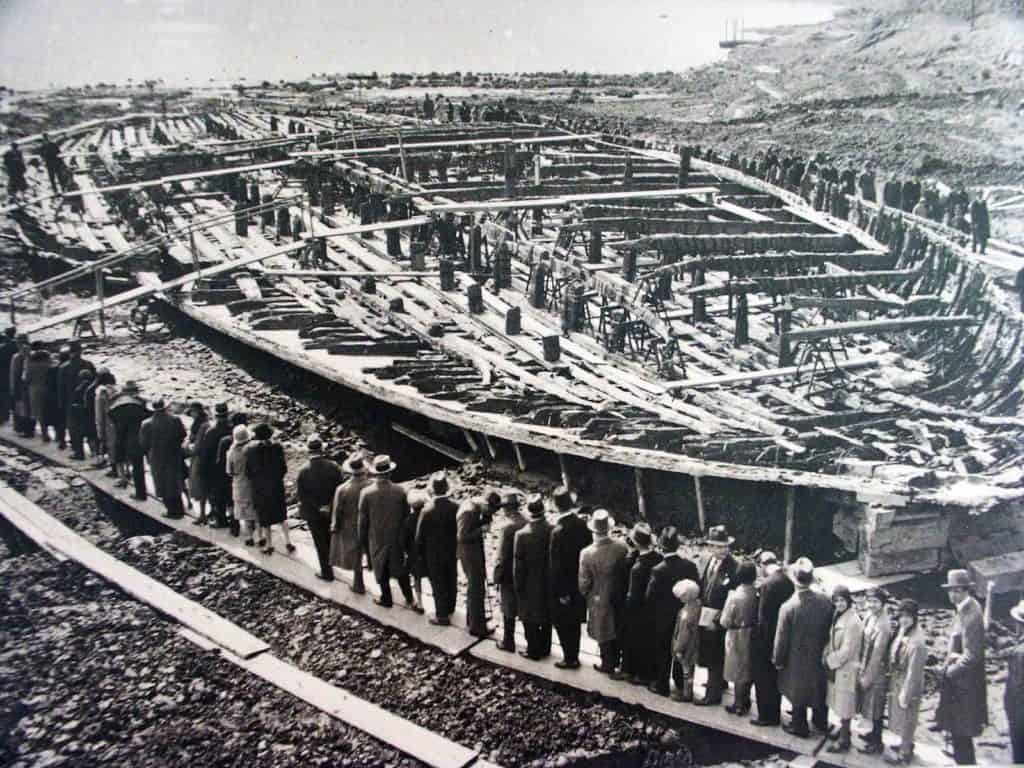
They were right in their decision. Over the centuries local fishermen had been picking away at the Nemi Ships, motivated less by archaeological curiosity than by the considerable potential to profit from salvaging (and subsequently selling) ancient artifacts: initially to local landowners, later to wealthy travelers on their grand tours. But despite the momentary abandonment of salvaging projects, those wanting to uncover the hidden wonders of the Nemi Ships wouldn’t have to wait long.
The breakthrough came under Mussolini’s fascist government in the 1920s. “Il Duce” was an ardent supporter of salvaging the Nemi Ships—eager as always to get his hands on anything Roman that would lend prestige to his party. He outlined his plan to drain the lake in a speech in 1927, and in October the following year, his project was put into action. The first ship emerged from the depths in March 1929; the second in June 1931. The wood of their vast carcasses was treated, artifacts were taken, and they were housed in the purpose-built Museo delle Navi Romane (Museum of the Roman Ships) on the shore of the lake.
<< Previous

The Third Ship
Some might think it ironic that the Nemi Ships survived for over 2,000 years underwater only to be destroyed within a decade of their life on the surface. But this is unfortunately what happened. On May 31, 1944, an unknown group of retreating German soldiers committed a malicious act of arson when they set the ships alight . By the time the Italians knew what had happened, it was too late. Aside from notes in the historical record, all that was left of Caligula’s magnificent vessels were cinders. As fortune would have it, however, it seems there is a third.
Mussolini’s party never drained the deepest part of the lake; rumored since the fifteenth century to be the resting place of a larger 400 feet long vessel. Like the other two ships, it’s likely to be excessively luxurious: resplendent with mosaicked floors, marble columns, gold decorations and (in its day) hot and cold running water. Nor is this ship’s existence just the stuff of rumors. Local fishermen have testified this ship’s existence by reporting Roman artifacts they find snagged up in their fishing lines.
The hunt is already underway. Various Italian authorities have teamed together to launch a cooperative (and therefore distinctly un-Italian) effort to search for the lost ship. Using hi-tech scanners, they have already identified an area some 100 feet deep for divers to scour. Things always move slowly in Italy, and so far they have only made it to a depth of 90 feet without much success. But within a few weeks, we should have a better idea of what—if anything—remains of this third titanic vessel .

While we wait for the third ship to be discovered, we’ll have to make to with the other ghosts from antiquity that continue to haunt Nemi. There are, however, many. As previously mentioned, Nemi derived its name from the Latin word for “holy wood”, and as well as being famous for its outstanding natural beauty (and debauched booze cruises aboard Caligula’s pleasure barges), Nemi was famous in antiquity for being the home to the Rex nemorensis , or the “King of the grove.”
Quite uniquely in the ancient world, this king could only be a slave who had run away from his master. He was, in reality, less a king and more a priest to the goddess of nature and hunting, Diana. However, like a king, he always faced the real and terrifying prospect of being violently supplanted by someone stronger. The removal of the incumbent king was in fact turned into a quasi-religious ritual, in which after plucking a golden bough from the grove, any other runaway slave could challenge the king to mortal combat. If the king won, he would retain his position. If not, his victor would take up the (dubiously attractive) title in his place.
Testament to the strength of Caligula’s attachment to the Nemi area is the fact that his story ties in with that of the Rex nemorensis . According to Suetonius, Caligula was a very jealous ruler and hated anybody who commanded even a morsel of power or respect. This extended beyond senators and popular theatre performers to include the King of Nemi himself. In the emperor’s opinion, one particular king had held his position for too long. So in a particularly spiteful act, Caligula decided to supplant him. He procured the strongest slave he could find and sent him to Nemi to fight the incumbent king. To cut a long story short: the defending king had far less longevity than either of Caligula’s pleasure barges.
Where Did We Find This Stuff? Some Sources and Further Reading
Daily Heritage – The Nemi Ships Were Elaborate Floating Palaces Built by Caligula In The 1st Century AD
Discover Magazine – Nemi Ships: How Caligula’s Floating Pleasure Palaces Were Found and Lost Again
History of Yesterday – The Pleasure Ships of the Roman Emperor Caligula Were The Yachts of Antiquity
The Local – Built by Caligula and smuggled to the US, a long-lost Roman mosaic finally returns to Italy
Rare Historical Photos – Italians viewing antique Emperor Caligula’s Nemi ships, 1932
The New York Times – Long-Lost Mosaic From a ‘Floating Palace’ of Caligula Returns Home
Seeker – Mystery of Emperor Caligula’s Party Ships Could Be Revealed After 2,000 Years
clock This article was published more than 6 years ago

Divers to scour lake for Emperor Caligula’s 2,000-year-old pleasure ship

Today, the serene waters of Lake Nemi make it a quaint getaway, one that is best known for its peaceful landscapes and the area's delicious wild strawberries.
But in ancient Roman times, the volcanic lake southeast of Rome was the anchor point for Emperor Caligula's pleasure ships — massive and ornate barges that were rumored to be the sites of wild orgies and other excessive indulgences.
For nearly 2,000 years, the sunken remains of Caligula's pleasure ships tantalized divers, who launched expeditions to recover them, with little success.
It wasn't until 1927, when Italian dictator Benito Mussolini ordered Lake Nemi drained, that two of the ships began to be fully revealed. Measuring 230 and 240 feet long, the “Nemi ships” recovered over the next several years astounded researchers with their advanced technology.
At the time, however, Lake Nemi was only partly drained — and in the decades since, rumors have persisted that the remains of a third, 400-foot-long pleasure ship lurk in the deepest part of the lake.
Local fishermen report getting their nets snagged in that area of the lake, only to bring up Roman artifacts, according to the Telegraph .
“We know from documents from the 15th century that one of the boats went down in an area of the lake different to where the other two were found during the Fascist era,” Alberto Bertucci, the mayor of the town of Nemi, told the newspaper.
Ancient Romans depicted Huns as barbarians. Their bones tell a different story.
Questions about whether a third pleasure barge belonging to Caligula is sunken in Lake Nemi could be answered soon. Divers on Wednesday will begin scouring the muddy lake bottom for the legendary ship using sonar and other modern equipment.
“If it’s down there, and it’s that long, then we are talking about the world’s first luxury cruise ship,” Bertucci told the Times of London . “Every emperor had a villa — but Caligula demanded floating villas complete with columns, hot water, gold and mosaics.”
Indeed, the pair of Caligula's pleasure ships found during Mussolini's time as prime minister revealed palatial furnishings and advanced naval mechanisms, including bronze statues, marble floors and lead pipes marked “Gaius Caesar Augustus Germanicus” (Caligula's full name) that would have carried hot and cold running water, according to a 2002 Films Media Group documentary .
“The Nemi ships are very important, partly because they are the most complete wrecks of their period ever found and because of their huge size,” Italian archaeologist Marco Bonino said in the documentary. “No other wrecks, whether on land or at sea, have provided so much useful information as the Nemi ships, both about construction techniques and about naval architecture.”
The two ships were housed in a museum near the lake but were destroyed in a World War II fire in 1944.
The cruelty and debauchery of Rome's third emperor have remained legendary through the centuries, although scholars debate whether the more salacious details of Caligula's life were exaggerated. He came into power in A.D. 37 but fell ill in the fall of the first year of his reign and began exhibiting, by all accounts, signs of disturbing mental illness.
Historical accounts of his authoritarian rule, bizarre requests and grandiose lifestyle depict someone who showed traces of Joffrey Baratheon from “Game of Thrones,” King Louis XVI and Scrooge McDuck.
Caligula spent untold sums of money on infrastructure projects, some on aqueducts and temples — but also once ordering hundreds of Roman merchant ships to create “a 2-mile floating bridge across the Bay of Bauli so he could spend two days galloping back and forth across it,” according to the History Channel . The network describes Caligula's personal exploits as similarly strange and lurid:
He tormented high-ranking senators by making them run for miles in front of his chariot. He had brazen affairs with the wives of his allies and was rumored to have incestuous relationships with his sisters. Caligula was tall, pale and so hairy that he made it a capital offense to mention a goat in his presence. He worked to accentuate his natural ugliness by practicing terrifying facial expressions in a mirror. But he literally wallowed in luxury, allegedly rolling around in piles of money and drinking precious pearls dissolved in vinegar. He continued his childhood games of dress-up, donning strange clothing, women’s shoes and lavish accessories and wigs — eager, according to his biographer Cassius Dio, “to appear to be anything rather than a human being and an emperor.”
Caligula often referred to himself as a god and had his enemies tortured and killed.
Throughout his reign, he continued to spend in excess, depleting the Roman treasury. The young emperor was assassinated in A.D. 41 by members of the Praetorian Guard, elite soldiers who were supposed to protect the emperor.
After Alexander, when art made the world smaller
A ship full of refugees fleeing the Nazis once begged the U.S. for entry. They were turned back.
A treasure hunter found 3 tons of sunken gold — and can’t leave jail until he says where it is
The mysterious shipwreck that swallows deep-sea divers who try to find it

- Welcome to History? ...
- Sing Along to the Spring Siren Song
- Ohio Ghosts Whisper....
- Major Archie Butt Had a Gift for Friendship, Even on the Titanic
- A Love Story for Valentine's Day - Marie Antoinette and Count Axel von Fersen
- Valentine's Day Crossword
- Titanic Headlines, Titanic Questions
- Robert St. John
- Joseph Morton
- Robert Cromie
- Agnes Meyer and Katherine Graham
- Walter Cronkite
- Sigrid Schultz
- Jack Denton Scott
- March is Women's History Month!
- Alcohol in American History - John Barleycorn Tells Some of His Story
- Ignoring History is Irrelevant
- Honoring a Veteran: Veteran's Day, November 11, 2012
- December 1, 1958: The Day Chicago Cried with Our Lady of the Angels
- Remembering the Vietnam War - 37 Years Present
- Rebellion, Murder, and Voting Rights in Rhode Island
- Words and Remembrance-May 1970 at Kent State in Ohio and Jackson State in Mississippi
- Rub-a-dub-dub in Your Historical Bathtub!
- The Freedom Summer Murders Changed American Racial Attitudes
- To Beard Or Not To Beard - That is the Historical Question
- Scarecrows Historically Speaking
- Diversionary Thoughts for the Dentists Chair
- Suzanne Valadon and Maurice Utrillo, Artists of Montmartre
- Grandmother Clara Zetkin Speaks
- High Stepping Ohio Horseman
- Philip Teitelbaum Creates a Money Making Machine
- The 1755 Lisbon Earthquake..
- Poul le Cour
- John Collier's Fight for Indian Rights and the First and Last Superintendent of Indian Affairs
- Lt. Colonel Ely Parker, First Native American Commissioner of Indian Affairs
- Clara and Henry Leffingwell - An English, American, and Australian Story
- The Murderer and the Museum Curator - Nathan Leopold and Kirtland's Warbler
- Wilbur Carr, the State Department, and Immigration - 1920-1945
- Billy Sunday Preached His Prayer Pennant Willing Baseball Story
- William Alden Smith, Michigan's Titanic Senator
- Helen and Dickinson Bishop Survive An Earthquake and the Titanic
- Faster Than Flames: Locomotive Engineer James Root Races the Hinckley Fire
- Three Hot and Contentious Weeks in July 1925 - The Scopes "Monkey " Trial
- The Confederados Become Brazilian, but Honor Their American Southern Roots
- Fascinating Footnote: The Goosedown Divorce
- Clara and Henry Leffingwell - An English, Australian, and American Story
- The Molly Maguires - Trailblazers or Terrorists?
- Lt. Uriah Phillips Levy Fights Prejudice and Saves Monticello
- The Stavisky Affair - Sasha the Suave Scammer
- General Santa Anna, Chicle, and Chewing Gum
- James J. Metcalfe, Gangbuster, Reporter, Poet
- Lucena Brockway Adapts to Life in the Keweenaw Copper Mining Country of Lake Superior
- Ida Tarbell- "Bachelor Soul." Transitional Woman, or Both?
- SOE Agent Andree Borrel Lived Several Lifetimes in Her 24 Years
- Ruth Becker's Faith Helped Her Survive the Titanic and Life Beyond
- Clara Zetkin Speaks Against Hitler in the German Reichstag
- Maria Mitchell, America's First Woman Astronomer
- Lee Lawrence Ansberry - The Courage to Live
- Lydia Latrobe Roosevelt and the First Mississippi River Steamboat
- Margaret Fox Kane's Victorian Love Story
- Chicagoan Kate Kellogg Meets a Ghost on a Train
- Acting History-History Plays
- Practicing History
- Power Point Pointers
- Pieces of the World History Puzzle
- Time Machine Tours
- Does Columbus Haunt His Ships...
- The Phantom Plowman
- The Western Reserve and the Gilcher
- The Ticonderoga's Haunted Bell
- The Train Chaser
- Mary Surratt
- Farmer Brunett's Ghost Lantern
- A Bicyclist Encounters a Phantom
- The Lady and the Patriot- The Fateful Voyage of Theodosia Burr Alston
- Operation Dynamo at Dunkirk- Snatching Soldiers from the Fingers of the Nazis
- Beaver Island - Mormon Kingdom, Fisherman's Paradise, Pirate Lair
- Captain Jedediah Spinnet and His Sons Caught Fish and Pirates
- Roman Emperor Caligula and His Legendary Lake Nemi Ships
- Great Lakes Steamers and the Black Hawk War
- Captain Harry Ward Cruised Gold Fields and Commanded a Slave Ship
- "Father Put Me in the Boat-" The Story of the Northfleet
- Gertie the Duck, Black Bill, and the Muffled Memorial Day Parade
- Verdun Belle Rescues a Shell-Shocked World War I Marine
- Storks are the Stuff of Legend and Every Day Life
- Susa White Gives Her Pet Lamb Nebby to Boston
- Sergeant Stubby, the World War I Dog
- Pistol Head, Cocker Spaniel, Combat Veteran
- Sallie the Civil War Heroine
- World War II Photographs by Sandy Blakeman
- Church Going is a Common Historical Experience
- Lydia Maria Child Writes and Explores Over the River and Through the Wood
- Solomon Linda, Mbube, Wimoweh, The Lion Sleeps Tonight
- Leroy Anderson Captures Fun and Feelings in His Music
- Mary Breckinridge, Circuit Riding Nurse and Founder of the Frontier Nursing Service
- George and Harry Washington Fight for Freedom
- Navy Diver Frank Prebezich Remembered Pearl Harbor by Salvaging Battleships
- Stan Valentine at Pearl Harbor
- World War II - Serving Aboard the USS Enterpise
- Michel Linovich-an Italian in Napoleon's Grand Army
- Charles Whittlesey- Scholar, Soldier, Humanist
- The Five Sullivan Brothers Stick Together...
- Kentuckian James Andrews and the Yankee Bridge Burners
- General Grant, General Babcock, General McDonald and Journalist Colony: A Study in Scandal and Friendship
- The Dudman Family Lived the Meaning...
- George Washington Travels French Creek to Fort Le Boeuf
- Miracle in World War I - the Christmas
- Presidents in a Package - Thomas Jefferson
- President James Monroe Inspects Michigan Territory - 1817
- President Grover Cleveland's Secret Surgery on the Steam Yacht Oneida
- John Kissinger Volunteers to Get Yellow Fever
- Mary Todd Lincoln Considered April Her "Season of Sadness"
- Violets for Valor - Two Bereaved Fathers in the Civil War
- Clarence and Mildred Beltmann - Persevering Through Hard Times
- Singing Kumbayah- Harmonious in Hope, Discordant in Derision
- James Bird - The Battle of Lake Erie, The Execution, The Ballad
- PDF Musical Muse- Music History
- Phil Ochs- A Musical Conscience of the 1960s and Beyond
- Dan Fogelberg and His Music
- Philip Paul Bliss and His Trunk of Songs
- Riding with Private Andrew Malone: For All of those who didn't Make it Home
- Do You Ken John Peel?
- "Mind the Music and the Step-" Yankee Doodle Sings History
- Back Water River and British Bluster
- Soldier's Stories
- September 11, 2001 is a "Mixed Feeling Day"
- Memories of Pearl Harbor
- Light and Radiance - Figure Skater Laurence Owen and Her Team
- Historic Halloween Tales
- Drive A Thanksgiving Turkey!
- Presidents in a Package - Abraham Lincoln
- Americans and Britons Celebrated Thanksgiving 1942 in War Weathered England
- Writing a Gratitude Journal for Thanksgiving Day
- Christmas Eve, 1941-A Sailor
- Alfred Burt and Wihla Hutson
- Milwaukee Soldiers and Sailors in World War II
- Throwing Out the First Pitch - American Presidents On Opening Day
- Kenesaw Mountain Landis
- Jim Rice - A Big Time Coach in a Small Town
- Playing Lucky Baseball with Lady Luck Sitting in the Catbird Seat
- The Angels Song - It Came Upon the Midnight Clear
- Mrs. Santa Claus- A Strong and Supportive
- Katherine Davis-The Little Drummer Boy
- Is There A Santa Claus? Virginia O'Hanlon and
- Carols Silent Night and O Holy Night
- Happy New Year
- Carl von Ossietzky Wins a Nobel Prize While in a Nazi Concentration Camp
- City Scapes
Roman Emperior Caligula and His Legendary Lake Nemi Ships
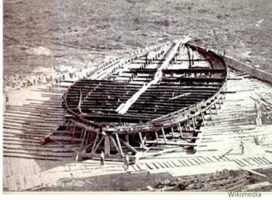

Two Roman Ships that Were Lost in WWII: What Destroyed the Floating Palaces of Emperor Caligula?
- Read Later
This is one of the most tragic stories about remarkable ancient artifacts you will ever read. After reading this article, you may have dreams about impressive ancient Roman ships that survived many centuries, only to be destroyed during World War II.
The ships built by the mad emperor Caligula in the 1st century AD looked like floating palaces. They were found at Lake Nemi and had everything that was characteristic of the hedonistic style of the Ptolemaic Period or the wealthy rulers of Syracuse (whose style inspired many bold feats in the ancient world.) This is what archaeologists recovered in 1929. However, fate soon gave the ships a tragic end.
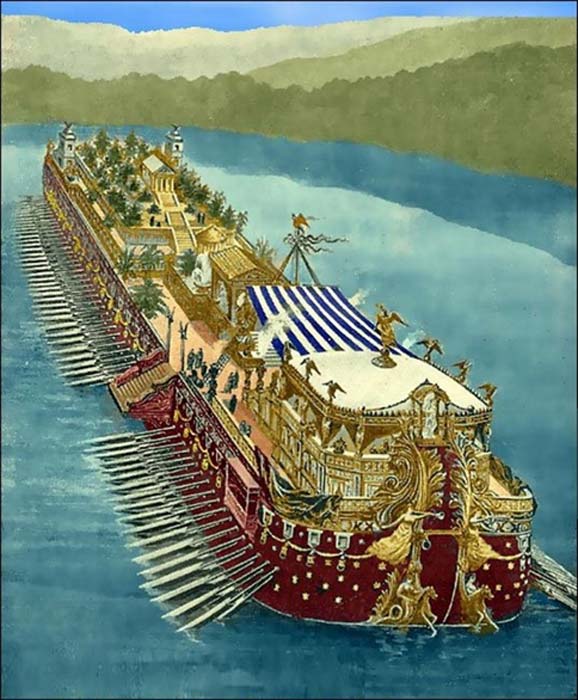
Imaginative depiction of one of the Nemi ships. Image courtesy of Ken Seamon
Discovering Caligula's Ships
Caligula had many unique ideas about religion; he followed the cult of Isis, but also loved Alexander the Great and imagined he could be his reincarnation. Two of his biggest desires were to be richer and to create more luxurious buildings than his ancestors. It is unknown why Caligula decided to make these ships, but it was likely his vanity. The impressive ships had amazing treasures and incredible decoration. They were like floating palaces with mosaic floors, a heating system, marble decorations, baths, etc.
- Ancient Journeys: What was Travel Like for the Romans?
- More Evidence that Ancient Romans May Have Made It to Oak Island, Canada
- The Well-Preserved Wreck of the Formidable Warship Mars
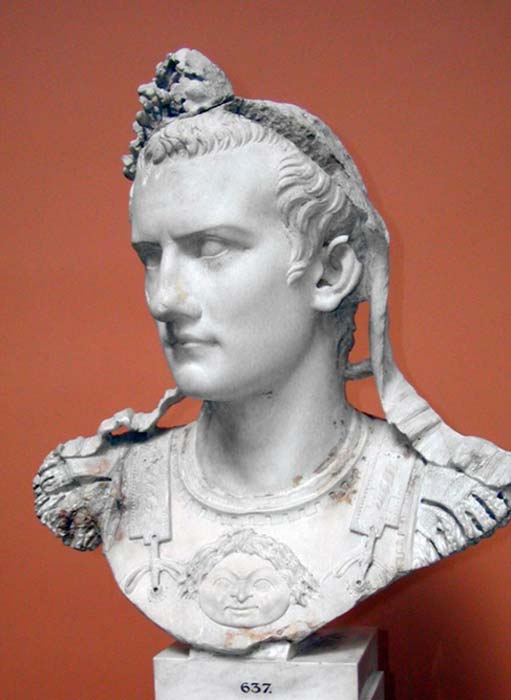
Reconstructed bust of the Emperor Gaius, known as Caligula. ( CC BY-SA 3.0 )
Lake Nemi is a small volcanic lake located in Lazio region. It is only 30 km (19 mi) south of Rome and was readily available to the ancient ruler of the Roman Empire.
The ships hadn't been lost for many centuries. Their location was known in the 15th century, when one of the most unexpected excavations in history took place. It is known that in 1446 an unusual expedition was led by Cardinal Prospero Colonna and Leon Battista Alberti. They analyzed resources and were able to locate the famous ships. At a depth of 18.3 meters (60 ft.), the first ''scuba divers'' tried to explore the site using a diving bell. The adventurous individuals who went to the sunken ships discovered bricks, copper, bronze, several artifacts, timber beams, and marble. The site became a source of precious artifacts. Most of them were sold and their fate remains unknown.
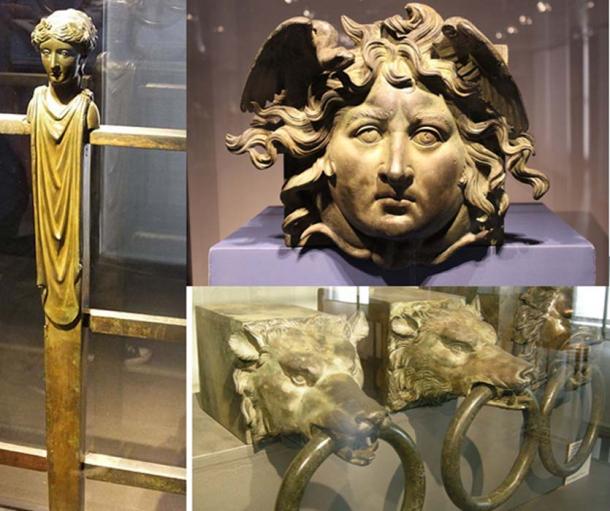
Some of the decorations from the Nemi ships: A bronze railing ( CC BY SA 2.0 ), a face (Miguel Hermoso Cuesta/ CC BY SA 3.0 ), and brass rings recovered in 1895. These were fitted to the ends of cantilevered beams that supported each rowing position on the seconda nave . ( CC BY SA 3.0 )
After several centuries of this looting, professional researchers started to work on one of the most remarkable projects in the 19th century – the recovery of the two ancient ships. Finally, in 1927, by the order of the Italian dictator Benito Mussolini, the specialists drained the lake and recovered the ancient vessels. They became a fascinating topic for the media and the main feature of an incredible museum dedicated to their history.
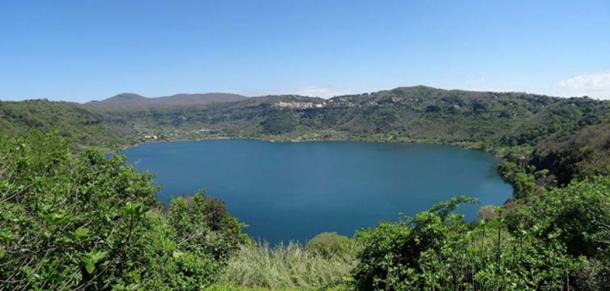
View of Lake Nemi from the Sacred Way. ( CC BY-SA 3.0 )
The Legendary Ships of Beauty
The first ship, mentioned in the literature as Prima nave, was 70 meters (230 ft.) long with a beam width of 20 meters (66 ft.), while Seconda nave (the second ship) was 73 meters (240 ft.) in length and had a beam width of 24 meters (79 ft.).
What did they look like? Apart from the rich material related to excavations, we can use the description of the ship that inspired Caligula's builders. The famous ship of Ptolemy IV Philopator, the king of Egypt who lived between 245 – 204 BC:
''As one first came on board at the stern, there was set a vestibule open in front, but having a row of columns on the sides; in the part which faced the bow was built a fore-gate, constructed of ivory and the most expensive wood. Entering this, one came upon a kind of proscenium which in its construction had been roofed over. Matching the fore-gate, again, a second vestibule lay aft at the transverse side, and a portal with four doors led into it. On both sides, left and right, potholes were set beneath to provide good ventilation. Connected with these entrances was the largest cabin; it had a single row of columns all round, and could hold twenty couches. The most of it was made of split cedar and Milesian cypress; the surrounding doors, numbering twenty, had panels of fragrant cedar nicely glued together, with ornamentation in ivory. The decorative studs covering their surface, and the handles as well, were made of red copper, which had been gilded in the fire. As for the columns, their shafts were of cypress-wood, while the capitals, of the Corinthian order, were entirely covered with ivory and gold. The whole entablature was in gold; over it was affixed a frieze with striking figures in ivory, more than a foot and a half tall, mediocre in workmanship, to be sure, but remarkable in their lavish display. Over the dining-saloon was a beautiful coffered ceiling of Cyprus wood; the ornamentations on it were sculptured, with a surface of gilt. Next to this dining-saloon was a sleeping apartment with seven berths, adjoining which was a narrow passage-way running transversely from one side of the hold to the other, and dividing off the women's quarters. In the latter was a dining-saloon, with nine couches, which was similar to the large saloon in magnificence, and a sleeping-apartment with five berths.''
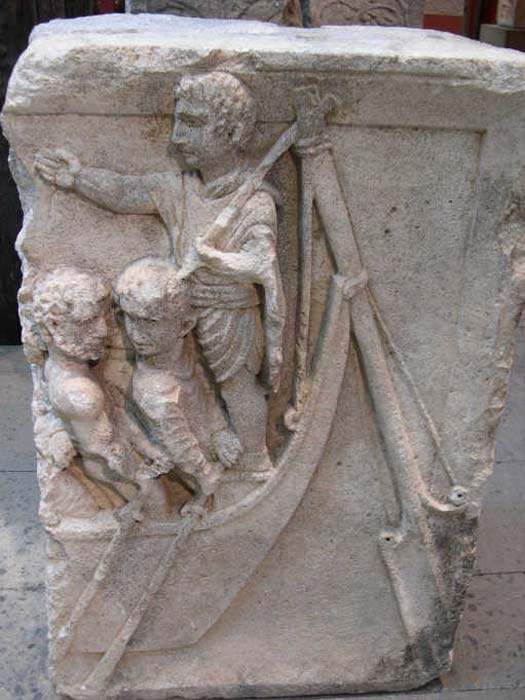
Stern-mounted rudder of a Roman boat, 1st century AD (RG-Museum, Cologne). ( Public Domain )
Caligula’s vessels were perfect examples of the best of ancient Roman shipbuilding. The Prima nave was a smaller ship, full of corridors and rooms. In fact, both ships had a complicated construction for unknown use. The Seconda nave was larger and had some structures on it. However, it is unknown in detail what kind of constructions were placed on that ship. One option that researchers suggest is a temple of Diana.

Reconstruction of Nemi Ship A. ( CC BY-SA 3.0 )
The Final Chapter of the Nemi Ships’ History
In 1944, all the world was touched by a war that had already lasted for five years. Sadly, the tragedy of war also had an impact on the famous wrecks. It was the night of May 31 when the museum was hit by the United States Army’s shells. The German artillery was destroyed, but the fire covered the entire museum and the ships too. The precious ships and their treasures were lost forever.
- 22 Shipwrecks spanning Ancient Era to the Renaissance discovered at Aegean archipelago
- The Antikythera Shipwreck – The Titanic of the Ancient World and its Sunken Historic Treasure
- 1600-Year-Old Cargo of a Roman Merchant Ship has been Discovered in Caesarea
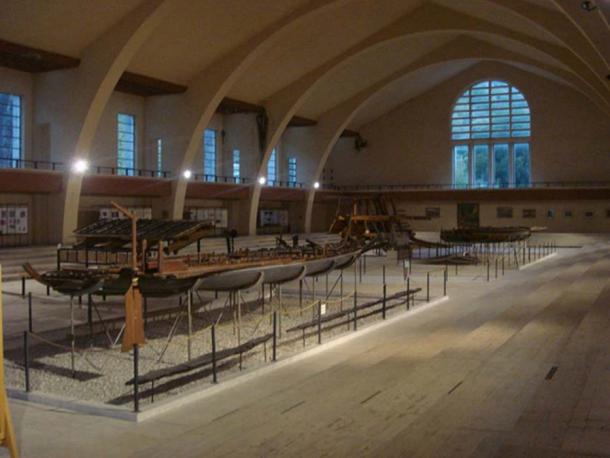
Nemi ships museum. ( CC BY-SA 3.0 )
After centuries of being protected by the lake, the cruelty of war destroyed these beautiful ships forever. Project Diana was launched by the Association Dianae Lacus (Lake of Diana Association) to preserve the historical treasures of Nemi Lake. The primary goal of the association (which was created in 1995) is to build a full-sized replica of the Prima nave ship.
The reign of Caligula was extremely expensive for the citizens of Rome. However, due to his attention to luxury and beautiful items, the period of his short rule (37 – 41 AD) is also one of the most fascinating. Unfortunately, Caligula’s fame didn't bring the expected support for Project Diana, which has mostly failed so far.
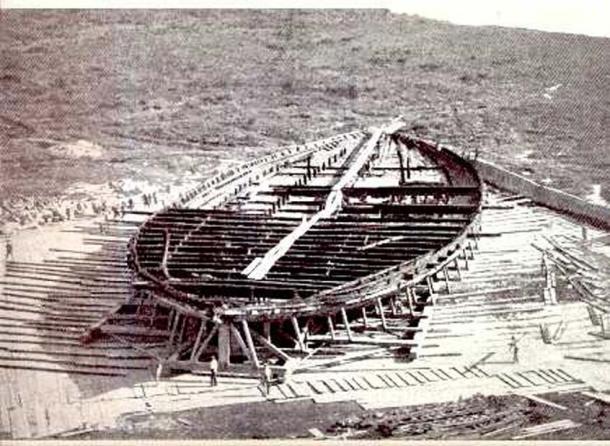
The remains of the hull of one of the two ships recovered from Lake Nemi. Workers in the foreground give an indication of scale. ( Public Domain )
Top image: Ancient Roman bronze face in the Palazzo Massimo alle Terme from the Nemi ships. Source: Miguel Hermoso Cuesta/ CC BY SA 3.0 and Artistic rendition of Caligula’s ships on Lake Nemi. Source: Mamma Maria’s Walking Tours
By Natalia Klimczak
References:
Caligula's Nemi Ships, available at: https://www.abc.se/~pa/mar/nemships.htm
Roman Emperor Caligula and His Legendary Lake Nemi Ships by Kathy Warnes, available at: http://historybecauseitshere.weebly.com/roman-emperor-caligula-and-his-legendary-lake-nemi-ships.html
World War 2, available ate: https://allthatsinteresting.com/tag/world-war-2
The Nemi Ships, available at: http://penelope.uchicago.edu/~grout/encyclopaedia_romana/miscellanea/nemi/nemi.html
Italians viewing antique Emperor Caligula's Nemi ships, 1932, available at: http://rarehistoricalphotos.com/caligula-nemi-ships-1932/
Zdzisław Skrok, Archeologia mórz, 1982.
Either the German or the Italian aggression in WW2
Sorry about that. Sorry the ships were destroyed. I’ll speculate we didn’t target those vessels., but we were in the war to win. Mussolini was just a dummy who bet on the wrong side. You guys should have bitched more about locking up with the Nazis.
To Shame: There is a picture as to the condition, the boats in that condition were transferred to the museum (similar to the way Viking and other boats are displayed), the museum was/is at Lake Nemi, although this was to be assumed but not directly stated.
At the end of the original article, presented today, as it was presented on March 21, 2017:
“It was the night of May 31 when the museum was hit by the United States Army’s shells. The German artillery was destroyed, but the fire covered the entire museum and the ships too. The precious ships and their treasures were lost forever.”
A lot of artifacts survived though, especially metal and non-flammable things and are in the museum, along with fifth-scale models of the boats. On TripAdvisor, hundreds of pictures by visitors to Museo delle Navi di Romane, as well as historical pictures are displayed
Not in the article because it happened after 2017, is that a section of the mosaic floor from one of the Nemi ships ended up in a New York 5th Avenue apartment, incorporated into a coffee table. It was requested by, and returned to, Italy as a national treasure.
Yet not one mention how during WW2 they were destroyed. Horrible article and very misleading title. It gives no information as to where they were or in what condition during WW2 and who, why, how they were destroyed. Amounts to shillery and click bate at it's lowest form.
Natalia Klimczak is an historian, journalist and writer and is currently a Ph.D. Candidate at the Faculty of Languages, University of Gdansk. Natalia does research in Narratology, Historiography, History of Galicia (Spain) and Ancient History of Egypt, Rome and Celts. She... Read More
Related Articles on Ancient-Origins
Roman Emperor’s ‘Floating Palace’ Puts Today’s Superyachts To Shame
The OG superyacht?
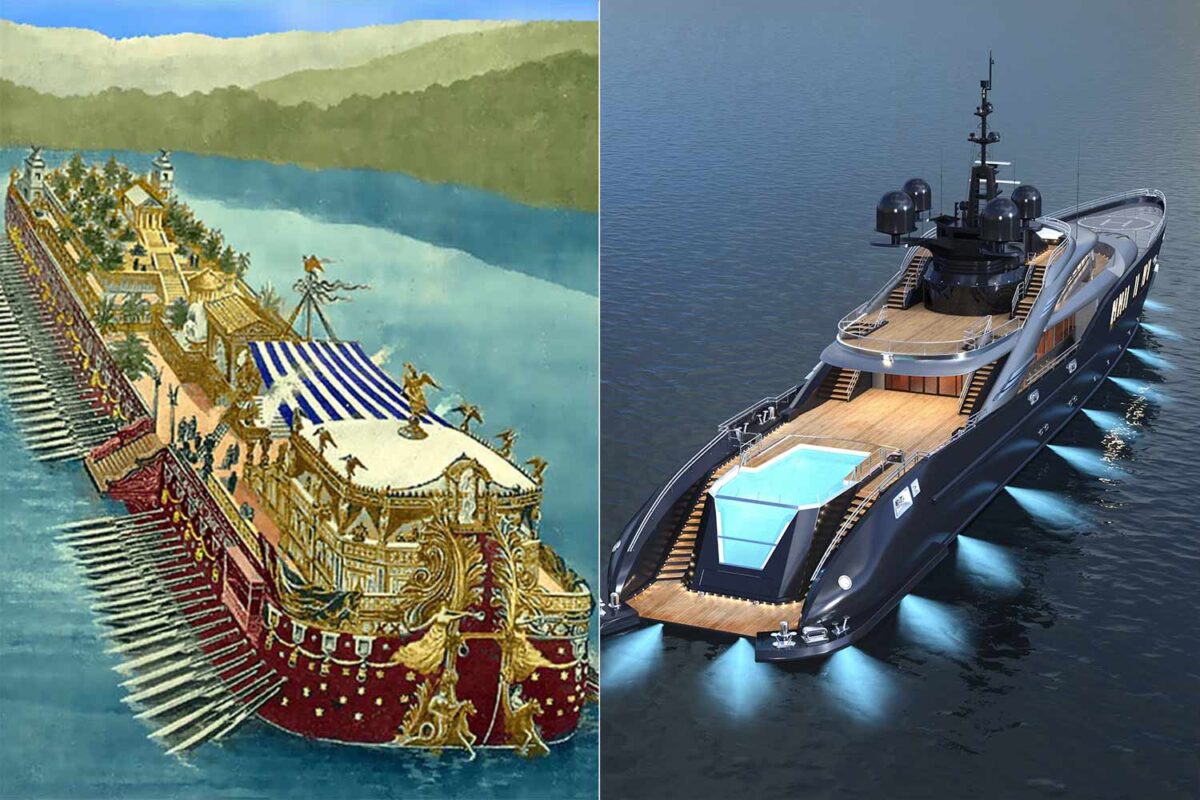
If you think we’re the only generation of humans to spend our wealth in depraved ways, think again: two ships built on Lake Nemi under the reign of the Roman Emperor Caligula show we’re not alone.
It’s surprising Roman Emperor Caligula was not throttled on his way to the throne. His father died at 33, most likely due to being poisoned by Emperor Tiberius, who saw Caligula’s family as a threat to his power. Caligula was then shipped off to live with various different family members, many of whom ended up getting whacked too. Eventually, he wound up in the care of the Emperor himself. While you might have expected Tiberius to have murdered Caligula, he actually came to care for him.
Caligula was smart. He won over both Tiberius and the senate so that when Tiberius died (it remains a matter of debate, with some believing it could have been from natural causes and others saying it was more likely by Caligula’s hand) he became Emperor.
Caligula had an impressive start as Emperor, lowering taxes and raising military wages, becoming known as a populist reformer. He made the people love him. But then he fell ill, likely due to poison. He recovered in body but not mind, thus entering a paranoid era. During this era, he had people killed for all sorts of reasons – political, personal and for the hell of it. He made people refer to him as a god. It’s even rumoured that he once ordered a whole section of the audience watching the gladiator games to be thrown into the arena.
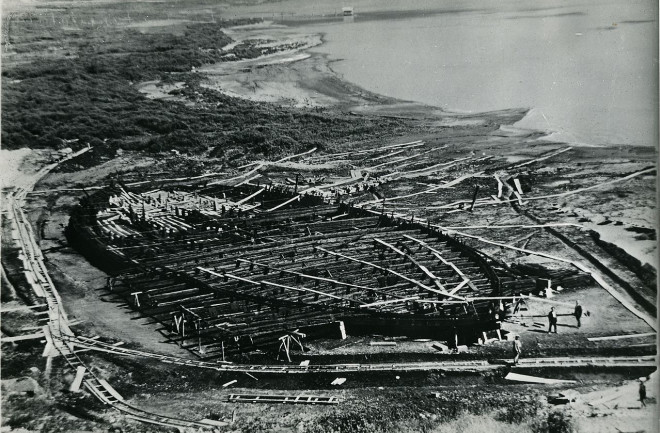
On the plus side, during this era, Caligula had two large luxurious ships built on Lake Nemi, a volcanic lake about 30 kilometres south of Rome. Some say they were built to send a message to the top dogs of Syracuse, Sicily, and Egypt (according to Windows of World History , “Caligula bragged that his ships were the most luxurious in the Hellenistic world”).
Others reckon one of the ships was made as a floating temple to Diana. Another popular theory, however, is that at least one of the ships was used as a floating pleasure house where Caligula could take a break from the pressures of running a kingdom into the ground while his compatriots tried to poison him, and indulge in the various depravities he was known for.
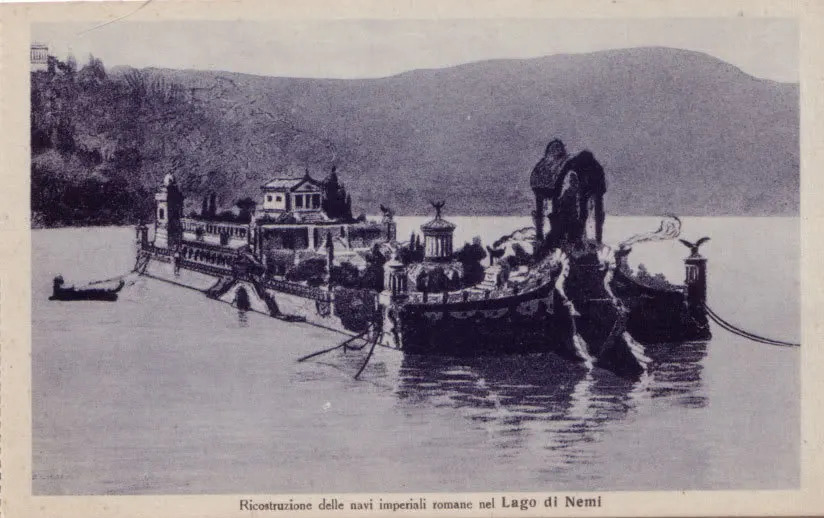
Apparently, these ships’ parties put Jeff Bezos, Dan Bilzerian, and your local European crypto bros’ debaucherous superyacht summers to shame. Caligula’s ships had huge bars, banquet halls and – according to Weird History – even a wide array of vines and fruit trees. Weird History adds: “Needless to say these ships functioned as floating soddoms and gommorahs.”
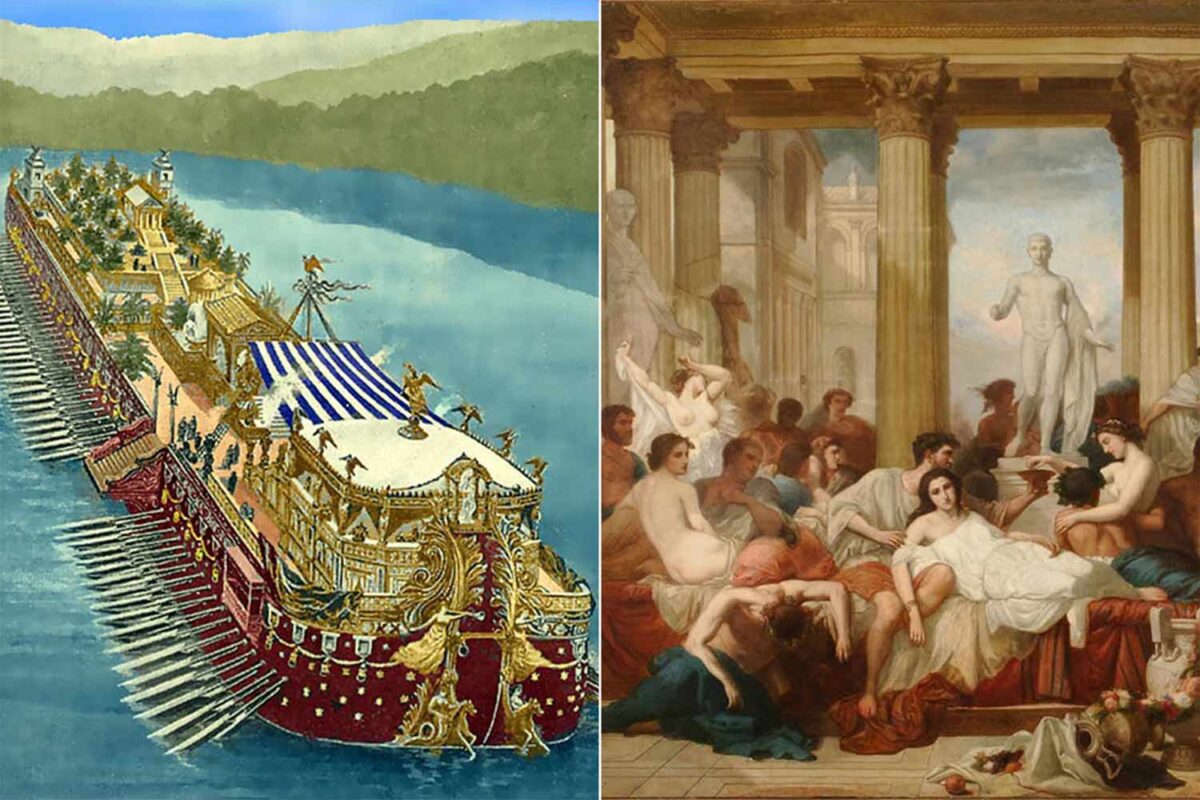
The two ships have been described as being built of cedar wood, dazzled with jewelled prows and rich sculpture. There were also, naturally, sails of purple silk, and bathrooms of alabaster and bronze (and vessels of gold and silver). The floors were also apparently paved with glass mosaic, the windows and door frames made of bronze, and many of the decorations were rare pieces of art.
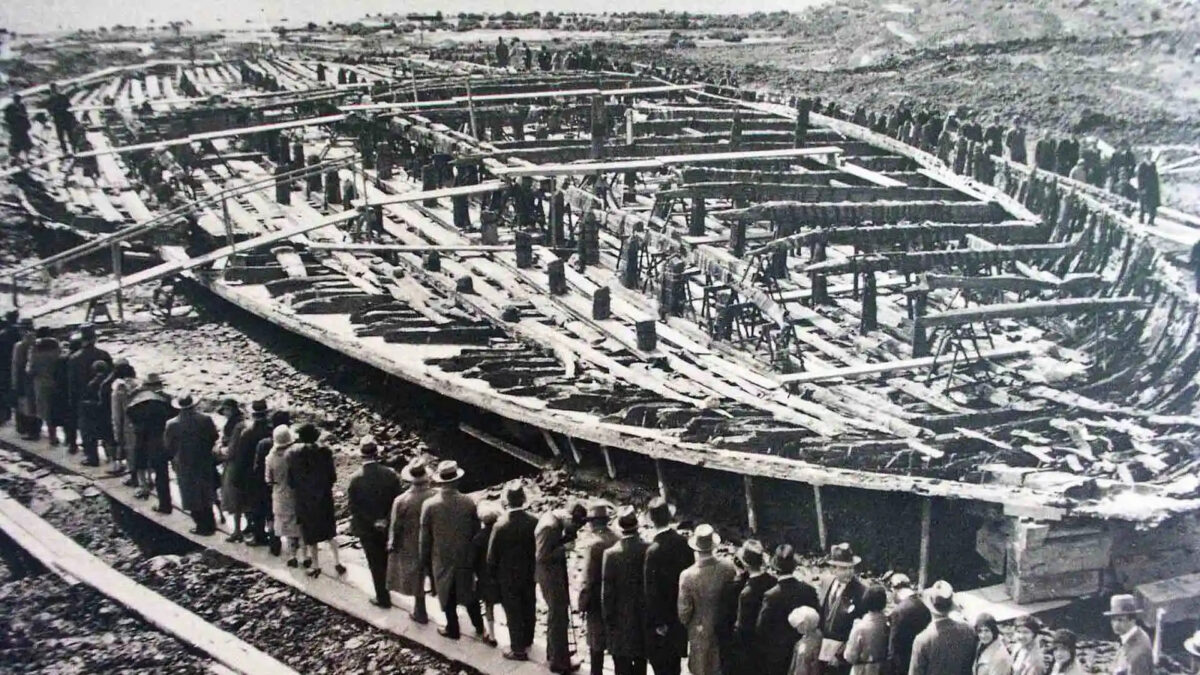
The ships were steered using 11.3 m quarter oars. The second ship (the bigger one) had four oars, two off each quarter and two from the shoulders. The first ship was equipped with just two. The big one was probably powered by oars. The smaller one was likely towed to the centre of the lake to be used. The ships were not very imaginatively named. Caligula called them primera nave and seconda nave .
RELATED: How Much Superyacht Crews Really Get Paid
In 41AD, when Caligula was 28, a senator led a conspiracy to murder Caligula and succeeded. After this, the boats were either sunk on purpose or sank due to neglect. The ships stayed on the bottom of Lake Nemi for 19 centuries, before fascist dictator Mussolini had the lake drained in 1928. This took three years. When they finished historians and archeologists discovered that the ships contained technology not thought to be used in Rome until later in Roman history (like piston pumps for water and a folding stock anchor).
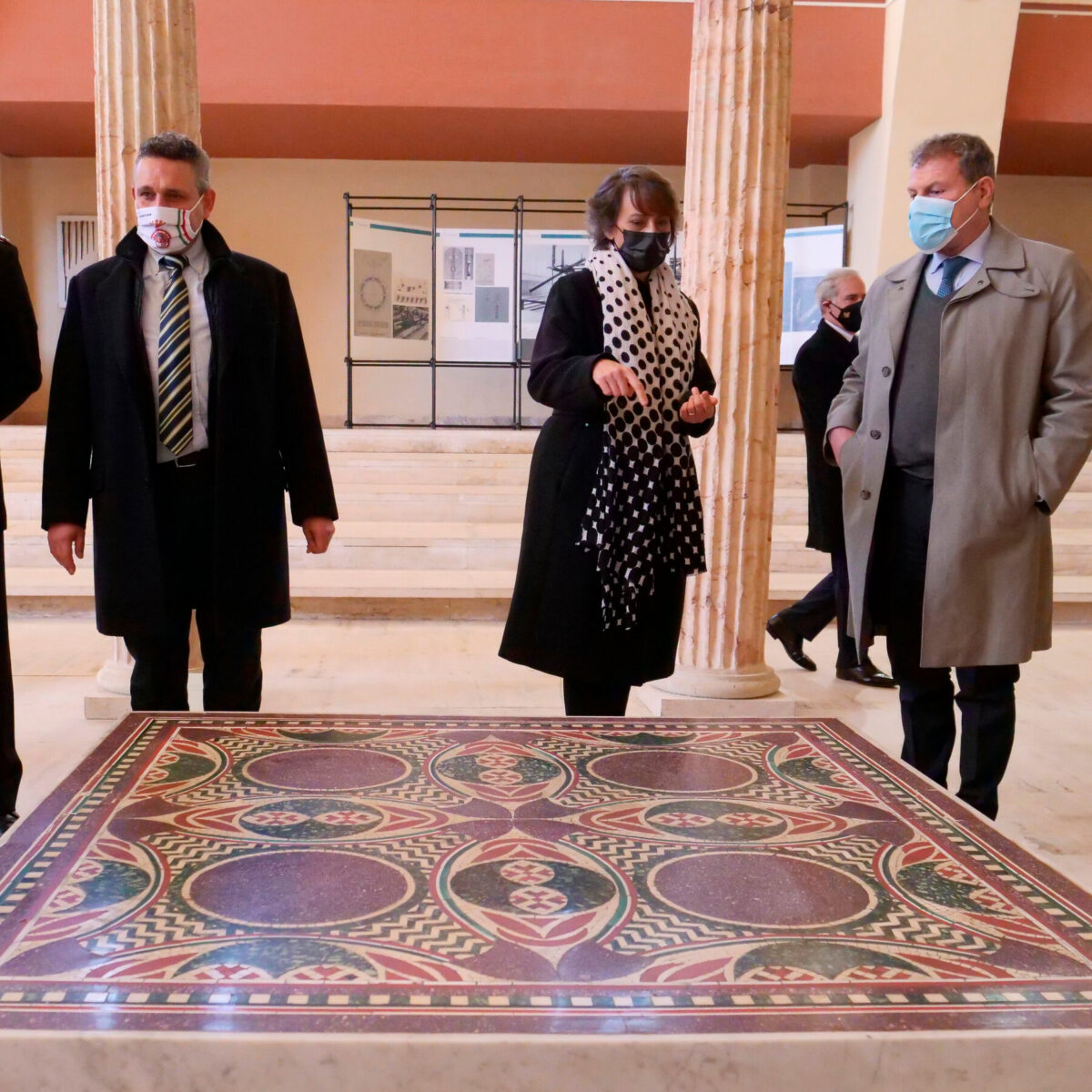
The remains were put in a museum. But in May 1944, the museum was either set on fire by fleeing Nazis or destroyed in a US air strike (it remains up for debate). Some remnants survived and were looted and smuggled out of Italy. A so-called “art squad” has made it its mission to recover some of these artefacts, in at least one case succeeding (a coffee table a wealthy New York couple bought in the 1960s was confiscated in 2017, as it turned out to be a piece of flooring from one of the Nemi ships).
RELATED: Germans Allegedly Swipe $5 Million of Art From Russian Superyacht
There you have it: it appears superyachts have been unimaginatively named throughout all of history (think: Super Yacht A). And perhaps also proof that humans haven’t changed as much as you might have thought over the course of 20 centuries…
- ‘The Chief Stew Jumped Into Bed With A Rapper’: Superyacht Worker Spills Their Wildest Tales
- The Two Year Process Of Building A $600 Million Superyacht
- Entertainment
- About DMARGE
- Editorial Policy
- Privacy Policy
- Affiliate Policy
- Terms & Conditions
- In The Media
- Corrections Policy
- Fact-Checking
Get the latest breaking news and original content across sport, entertainment, luxury and travel.
Roman Emperor Caligula's massive party ships were not burned by the Nazis during World War II, researchers say. A US artillery unit was to blame.
- For decades, many believed the Nazis were responsible for the destruction of Caligula's Nemi ships.
- The massive first-century boats were used for the debauched Roman emperor's love for partying.
- A new book argues that US artillery was accountable for the burning of the ships, The Times reports.

The history behind the destruction of two boats known as the Nemi ships that belonged to the notorious Roman Emperor Caligula has been shrouded in mystery . While many believed the Nazis burned them during World War II, a new book finds that a US artillery unit was responsible for their destruction.
Caligula, known for his taste for opulent luxury and love of outlandish parties, had the "pleasure boats" equipped with artwork – including marble statues and mosaics , archeologists believe. The massive party boats — measuring between 230 and 240 feet — stationed on Lake Nemi in Italy were ahead of their time, as they had a plumbing system for running water, according to Atlas Obscura .
While it is unclear why the boats sank, popular mythology says that Caligula — ruler of Rome from 37 AD until his assassination in 41 AD — sank the ships himself during a "drunken orgy," according to the travel outlet.
Caligula's boats were recovered from the bottom of the lake in the early 20th century and kept in a museum by Italy's fascist leader Benito Mussolini. However, the relics were destroyed during the war in a fire.
At the time, it was widely believed that Hitler's Nazis were responsible for the burned ships. But a new book shines a light on their history — claiming it was a US artillery unit that burned the vessels.
Related stories
"It was easier to point the finger at the Germans, and the report was a hurried attempt to blame them," Stefano Paolucci, a historian and co-author of the forthcoming book "The Burning of the Nemi Boats," told The Times .
'Whoever is doing the fighting, war is always destructive'
A report at the time written with the support of US and British officials found that the boats were burned by Nazi troops in 1944, according to The Times, accusing the Germans of committing a "crime against civilization."
A 1944 New York Times headline read , "NAZIS BURN GALLEYS OF ANCIENT ROMANS."
"The Germans denied it, but that's been the view for 80 years before we analyzed the report and realized it didn't add up," Flavio Altamura, an archeologist and coauthor of the book, told The Times.
The two researchers believe that US shells struck the museum roof during the war, which likely caused smoldering shrapnel to hit the wooden boats that had been treated with flammable tar, causing them to catch fire. Other reports at the time that corroborated their theory were overlooked at the time, they said, because of embarrassment by the Allied forces.
The researchers also argued that an Italian heritage official who led the inquiry into the destruction of the ships was eager to blame the Germans and ingratiate himself with the Allies to overlook his ties to fascism.
"Our research won't give us back the boats, but we believe we have cleared up the mystery and shown that whoever is doing the fighting, war is always destructive," Altamura told The Times.
Correction: May 10, 2023 — An earlier photo caption in this story misidentified the ammunition seen in the photo. The World War II artillery rounds pictured weren't mortar shells.
- Main content
Watch CBS News
Roman Emperor Caligula's coffee table
By Brit McCandless Farmer
Updated on: March 10, 2024 / 7:01 PM EDT / CBS News
When stains had to be cleaned from a mosaic that once decorated a lavish pleasure vessel from the first century, they were not remnants from the debauched revelries that the murderous and sex-crazed Roman Emperor Caligula used to hold on the ship.
Instead, they were vestiges of modern, everyday life from a New York City apartment almost 2,000 years later. But exactly how the mosaic ended up as a coffee table in a Park Avenue living room is still something of a mystery.
The mosaic is a four-and-a-half square-foot geometric piece made up of rich green and white marble and purple-red porphyry, a type of rock textured with crystals that was frequently the choice of Roman emperors. It had been part of an inlaid floor in one of the gigantic and extravagant party ships commissioned by the emperor Caligula, a much-despised ruler whom history has described as cruel, depraved — and maybe even a little deranged.
When Caligula was assassinated in A.D. 41 after ruling for only four years, his two ships were sunk where they sat, in the middle of Lake Nemi, a small volcanic lake southeast of Rome.
Over the ensuing centuries, several attempts had been made to raise the opulent ships from the lake. Italian Renaissance architect Leon Battista Alberti first attempted to salvage remnants in the mid-15th century but was ultimately unsuccessful. Then in 1895, divers conducted a thorough survey of the site and began resurfacing relics from the lake's mud floor. That is when archaeologists unearthed certain colorful stone mosaic tile.
"The deck must have been a marvelous sight to behold, and it goes beyond the power of imagination for its strength and elegance…" Italian archaeologist Rodolfo Lanciani wrote of the discovery in an issue of The Youth's Companion, according to an 1898 article in The New York Times . "Last of all comes the pavement trodden by imperial feet, made of disks of porphyry and serpentine, not thicker than a silver dollar, framed in in segments and lines of enamel, white and gold, white and red, or white, red, and green. The colors are perfectly brilliant. Fancy the deck of a modern yacht inlayed in enamel."
Stretching 230 feet and 240 feet long and mostly flat, the wood ships were clearly constructed as barges meant to sit in placid water, not to negotiate waves. According to The New York Times in 1908, the ships were topped with silk sails and featured orchards, vineyards, and even bathrooms with running water ("quite unnecessary when one can so easily jump overboard," the Times offered). To be certain whose ship bore such luxurious accommodations, the lead pipes were inscribed Gaius Caesar Augustus Germanicus, Caligula's official name, according to a 1906 issue of Scientific American .

It would not be until the twentieth century that the ships' full grandeur was revealed. Fascist dictator Benito Mussolini was so taken by Caligula — whose legend includes turning his palace into a brothel and appointing his horse as a high-ranking senator — that he ordered Lake Nemi be partially drained so the two ships could be raised. In the early 1930s, Mussolini commissioned a museum next to the lake to house the ships and their treasures once they were recovered.
But after sitting submerged for nearly 1,900 years, Caligula's floating dens of debauchery would not see dry land for long. During World War II, Nazis used the museum as a bomb shelter, and the Italians of Nemi allege the retreating Germans set fire to the building in 1944, destroying most objects inside.
Destined to hold idling beverages on Manhattan's Upper East Side, the colorful mosaic floor tile bears no evidence of this fire damage. Dario Del Bufalo, an Italian expert on ancient marble and stone, told 60 Minutes correspondent Anderson Cooper this suggests the mosaic had either been snuck out of the museum before the fire or had been in private hands since Mussolini had it extracted from the lake in the 1930s.
At some point after World War II, the mosaic disappeared. Del Bufalo included a photo of it in a book on porphyry he published in 2013, and during a lecture and book signing at the Bulgari jewelry store on Manhattan's 5th Avenue, he overheard a remarkable conversation.
"There was a lady with a young guy with a strange hat that came to the table," Del Bufalo said. "And he told her, 'What a beautiful book. Oh, Helen, look, that's your mosaic.' And she said, 'Yeah, that's my mosaic.'"
Shocked by the statement as much for its substance as its nonchalance, Del Bufalo quickly wrapped up signing books and sought out the pair. He found the young man who told him that yes, this is Helen's coffee table at her home on Park Avenue.
The Helen in question is Helen Fioratti, an art dealer who owns a gallery for European antiques and lives in Manhattan. She told The New York Times in 2017 that she and her husband, Nereo Fioratti, a journalist, had bought the piece in good faith from an Italian noble family in the 1960s and had no reason to suspect they were not the mosaic's rightful owners. Once the Fiorattis brought the mosaic home to their Park Avenue apartment, they affixed it to a base to turn it into coffee table.
"It was an innocent purchase," Fioratti told the Times in 2017. "It was our favorite thing, and we had it for 45 years."
But prosecutors for the Manhattan district attorney's office say evidence suggests the mosaic had been stolen from the Nemi museum, also according to The New York Times . In September 2017, they seized the mosaic and returned it to the Italian government.
60 Minutes' request for comment from Fioratti went unreturned.
Del Bufalo told 60 Minutes he sympathizes with Fioratti. "I felt very sorry for her, but I couldn't do anything different, knowing that my museum in Nemi is missing the best part that went through the centuries, through the war, through a fire, and then through an Italian art dealer, and finally could go back to the museum," he said. "That's the only thing I felt I should have done."
After receiving a thorough cleaning to remove all traces of its former life as host to coffee, tea, and the occasional flower vase, the mosaic was unveiled on display at Nemi's Museum of the Roman Ships in 2021.
In the meantime, Del Bufalo, had fashioned a convincing replica of the mosaic. He told 60 Minutes he wants to make a copy for Fioratti to return to her apartment on Park Avenue, because as he explained, "I think my soul would feel a little better."
The video above was originally published on Nov. 21, 2021 and was produced by Andy Court, Brit McCandless Farmer, and Will Croxton. It was edited by Will Croxton.
Brit McCandless Farmer is a digital producer for 60 Minutes, for which she has won two Webby Awards and numerous Telly Awards. Previously, Brit worked at the CBS Weekend Evening News, CBS This Morning, CNN, and ABC News.
More from CBS News

Why rape survivors and exonerees went on a retreat together

Capturing the emotional journey of Healing Justice

Crime victims form unlikely bonds with wrongfully convicted men

Where Russians go after speaking out against Putin
Advertisement
Supported by
Royal Yacht or Fishing Trawler? Either Way, Even the Royal Family Isn’t Interested.
For Prime Minister Boris Johnson, the proposed $280 million vessel would serve as a symbol of Global Britain. To critics, it’s an ill-conceived boondoggle.
- Share full article

By Mark Landler
LONDON — The naval architect who designed the Queen Mary 2 likened it to a “1950s fishing trawler, ” while a retired Navy admiral sniffed that the plans for it looked like an “oligarch’s yacht.” A Conservative Party grandee ridiculed it as a “complete waste of time, silly populist nonsense.”
The target of all of this venom is Prime Minister Boris Johnson’s latest pet project: a replacement for the royal yacht Britannia, mothballed in 1997. Mr. Johnson wants to spend 200 million pounds, or $280 million, to build a new Britannia — not as a plaything for the royal family, which has evinced no interest in another yacht, but as a floating brand ambassador for post-Brexit Britain.
“This new national flagship will be the first vessel of its kind in the world,” the prime minister declared recently, “reflecting the U.K.’s burgeoning status as a great, independent maritime trading nation.”
For Mr. Johnson, whose fondness for grand projects ranges from an island airport in the mouth of the Thames River (never built) to a sleek new fleet of double-decker buses for London (built), the appeal of a new Britannia is obvious. With Britain eager to strike trade deals around the world, it could dispatch the yacht to distant ports as a visible manifestation of the Global Britain that Mr. Johnson says was birthed by Brexit.
But the project, which is also championed by the pro-Tory paper The Daily Telegraph, has been caught up in the pesky arithmetic of public finances. The Johnson government is already busting its budget to cushion the economic blow from the pandemic. It is splashing out billions of pounds on big-ticket projects like a high-speed rail link — part of Mr. Johnson’s promise to “level up” inequities between the country’s hard-knocks north and its prosperous south.
To its critics, a royal yacht is a folly — an unaffordable vanity project from a government grasping for atavistic symbols of Britain’s greatness.
“It’s a symptom,” Kenneth Clarke, a former chancellor of the Exchequer and senior figure in the Conservative Party, told the BBC. “Two hundred million pounds is not going to cause problems. But it shows there are people in No. 10 who just think there’s free money and who think that waving a Union Jack and sending yachts and aircraft carriers around the world shows what a great power we are.”
Mr. Clarke was purged from his party in Parliament by Mr. Johnson in 2019 after he voted against one of the government’s Brexit deals. He had previously blocked a plan to replace the Britannia in the 1990s when he was serving under Prime Minister John Major, according to Richard Johnstone-Bryden, who wrote a history of the Britannia and supports the proposal to replace it.
Still, even more sympathetic members of Mr. Johnson’s party have pronounced the idea “daft,” with some predicting it would end up like other chimerical Boris Johnson projects. As mayor of London, he championed a pedestrian bridge across the Thames, topped with trees and a garden. The bridge never made it past blueprints, though it still ended up costing more than $70 million in contracts and other planning costs.
Mr. Johnson also latched on to the idea of an airport to replace Heathrow. To be built on an artificial island in an estuary of the Thames River at a projected cost of tens of billions of dollars, it was perhaps inevitably nicknamed “Boris Island” by the British press. Mr. Johnson is still beguiled by a proposal to build a 28-mile bridge connecting mainland Britain with Northern Ireland.
By these Xanadu-like standards, a $280 million boat is modest. Government officials argue it would pay for itself many times over by helping secure trade deals, military contracts and private investment in Britain.
During its 44 years of service, the Britannia was a reliable closer for the government: Once, after Mr. Major had negotiated $2 billion in contracts during a trip to India — he traveled there by plane — the yacht was dispatched to help the British nail down signatures from foot-dragging Indian officials.
“It’s not a silver bullet in the sense that if you build a royal yacht, your economy doubles overnight,” Mr. Johnstone-Bryden said. “But because of the yacht’s prestige, you can attract top officials for an event promoting a particular industry. Receptions at embassies or hotels don’t have the same draw.”
He likened the Britannia’s iconic status to that of Air Force One. In the same way that the American president’s customized blue-and-white 747 symbolizes the global reach and power of the United States, a royal yacht pays tribute to Britain’s mighty seafaring history. “I’m sure it would be inconceivable to many Americans to retire Air Force One without replacing it,” he said.
In truth, Britain has done just fine without the Britannia. While Queen Elizabeth II famously wiped away a tear when she attended the yacht’s decommissioning ceremony, the royal family has been resolutely silent about replacing it. According to The Daily Mail, it demurred at a proposal to name the new vessel the Duke of Edinburgh, after the queen’s husband, Prince Philip, who died in April . The duke, a former naval officer, had a hand in designing the original Britannia.
Under the influence of Prince Charles, the royal family has become sensitive to showy displays of wealth, particularly when they drain the public purse. The queen, who is 95, does not travel overseas anymore, so the yacht would be used by her heir, Charles, and his son, Prince William, neither of whom have her emotional connection to the Britannia.
Some question whether the whole concept of a royal yacht is superannuated in an era in which Britain is negotiating complex bilateral trade agreements with Australia, the United States, and other countries.
“At the very most, it could be useful as a trade promotion tool,” said Sam Lowe, a trade expert at the Center for European Reform in London. “But it won’t make even the tiniest difference to whether U.K. concludes a trade deal or not.”
Nor does the yacht have an obvious military purpose, even if the defense ministry would be likely to supply its crew and foot at least part of the bill for its operation.
But all of this may be missing the point. Andrew Gimson, one of Mr. Johnson’s biographers, said his pet projects — whether groovy retro buses or garden-topped bridges — invariably serve a political purpose. Mr. Johnson, he said, is akin to a Roman emperor putting on public spectacles. A royal yacht evokes the glories of Britain’s imperial past for a country still groping for a post-Brexit identity.
“There’s at least some working-class voters who would love this,” Mr. Gimson said. “And it’s yet another way of teasing the intelligentsia.”
If that is the case, the biggest problem with Mr. Johnson’s yacht may be that it is a bit dinky. An artist’s rendering issued by Downing Street drew catcalls. Stephen Payne, a naval architect who designed the Queen Mary 2 to evoke the great ocean liners of the past, said the yacht would be too small to have adequate exhibition and conference space. As currently designed, it has only two masts; a royal yacht needs three — to fly the royal standard, the Union Jack and the flag of the admiralty.
The government has said little about the design process. Scuttlebutt in the industry is that it went to a Finnish ship designer. Mr. Payne, who submitted his own design, said the government’s yacht would look more at home unloading its catch in the fishing port of Hull than presiding in the royal dockyard in Portsmouth.
“I really wonder whether the people involved in it understood what they were doing,” he said. “That bridge front looks very much like a Hull fishing trawler.”
Mark Landler is the London bureau chief. In 27 years at The Times, he has been bureau chief in Hong Kong and Frankfurt, White House correspondent, diplomatic correspondent, European economic correspondent, and a business reporter in New York. More about Mark Landler
News | Icelandic Parents Inspired by Yacht and Roman Emperor
Icelandic Parents Inspired by Yacht and Roman Emperor
- Iceland Review
- November 9, 2016
Snekkja (‘Yacht’) has been accepted as a girl’s name in Iceland by Mannanafnanefnd, the Icelandic Naming Committee, mbl.is reports.
The committee reasoned that there are many examples for nouns being used as names, including Nökkvi, a boy’s name, which also means ‘boat.’
Neró, the name of a Roman emperor, has also been accepted as a boy’s name. The committee is supposed to make sure that a name will not cause harm to the person bearing it, so it considered rejecting Neró, since the emperor persecuted Christians and has been described as the Anti-Christ.
However, the committee concluded that people were unlikely to connect events in distant history with a person bearing the name Neró in Iceland today and, hence, approved it. Both Júlíus and Sesar (Ceasar) are approved male names in Iceland.
Other recently-approved names are Skjaldmey and Manasína for girls and Lyngþór and Eir for boys—until now, Eir has only been used as a girl’s name.
Sign up for our weekly newsletter
Get news from Iceland, photos, and in-depth stories delivered to your inbox every week!
Subscribe to Iceland Review
In-depth stories and high-quality photography showcasing life in Iceland!
Share article
Recommended Posts

New Eruption Lengthier Than Previous Ones

Presidential Race Heats Up
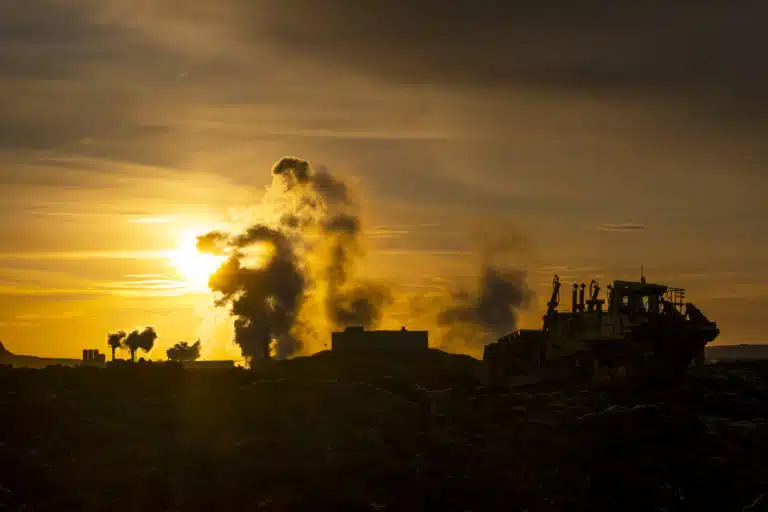
Svartsengi Geothermal Power Station Evacuated Due to Air Pollution

More Icelanders Seek Help of Financial Advisers Than Before

Lava Flow Not Likely to Reach Southern Highway or Sea
- New Eruption Begins in Reykjanes
- Lava Flow Nearing Small Farm and Sea
- Scientists Forecast End to Geological Unrest Near Grindavík
- Is the Blue Lagoon in Iceland open after the eruption?
- Five Magma Intrusions, Three Eruptions
- Tourists Flock to Unmarked Hot Spring in North Iceland

IMAGES
VIDEO
COMMENTS
The remains of the hull of one of the two ships recovered from Lake Nemi.Workers in the foreground give an indication of scale. 1930 The remains of a Lake Nemi ship in 1929. The Nemi ships were two ships, of different sizes, built under the reign of the Roman emperor Caligula in the 1st century AD on Lake Nemi.Although the purpose of the ships is speculated upon, the larger ship was an ...
Emperor Caligula, like his predecessor Emperor Tiberius, liked to spend his summers sailing in Lake Nemi. Caligula ordered two large ships, more than 70 meters long, which he intended to use during his vacations. One ship was a floating temple dedicated to the goddess Diana. The other was a floating pleasure palace.
The largest was 240 feet in length, the same length as an Airbus A380, and measured 79 feet across. From inscriptions on lead pipes and tiles, it soon became clear that what had been discovered were the floating pleasure palaces of the infamous first century Roman Emperor Caligula. The larger of the two Nemi pleasure palaces.
As one of his royal passions, Emperor Caligula ordered several large barges to be built to use on Lake Nemi. The two vessels, which were designated in modern times as Prima Nave and Seconda Nave, (First Ship and Second Ship), had dimensions of 70m x 20m (230ft x 66ft) and 73m x 24m (240ft x 79ft) respectively.. While there can be little doubt that the ships were built at the capricious whim of ...
The Roman emperor's prized boats boasted marble, gold, and running water. by Cara Giaimo April 10, 2017. Divers in Italy Are Searching for Caligula's Last, Lost Pleasure Ship
The emperor's real name was Gaius Caesar Augustus Germanicus. Caligula, meaning "little boot," was a nickname given to him by his father's legionaries. Caligula had an excellent pedigree. He was the grand grandson of the first Roman Emperor Augustus. He ruled only for four years before being slaughtered by his own Praetorian Guard.
History of Yesterday - The Pleasure Ships of the Roman Emperor Caligula Were The Yachts of Antiquity. The Local - Built by Caligula and smuggled to the US, a long-lost Roman mosaic finally returns to Italy. Rare Historical Photos - Italians viewing antique Emperor Caligula's Nemi ships, 1932
By Amy B Wang. April 4, 2017 at 1:26 p.m. EDT. Today, the serene waters of Lake Nemi make it a quaint getaway, one that is best known for its peaceful landscapes and the area's delicious wild ...
The citizens of Rome, many Roman soldiers, and visitors from the provinces and conquered lands come to admire Caligula's Nemi ships. Caligula Dedicated the Largest Nemi Barge to Moon Goddess Diana. Caligula dedicated the largest ship he had built to the moon Goddess Diana. The largest ship resembled one of his palaces transported to water and ...
Oct. 19, 2017. The ceremonial ships that the Roman Emperor Caligula built to host decadent festivities on Lake Nemi were ornate floating palaces, with pink marble columns and brightly colored ...
Stern-mounted rudder of a Roman boat, 1st century AD (RG-Museum, Cologne). (Public Domain) Caligula's vessels were perfect examples of the best of ancient Roman shipbuilding. The Prima nave was a smaller ship, full of corridors and rooms. In fact, both ships had a complicated construction for unknown use.
Apparently, these ships' parties put Jeff Bezos, Dan Bilzerian, and your local European crypto bros' debaucherous superyacht summers to shame. Caligula's ships had huge bars, banquet halls ...
A New York City woman's coffee table was discovered to be part of a dance floor from ancient Roman emperor Caligula's party yacht. Morgan Keith. Nov 27, 2021, 10:05 PM PST. Architect Dario del ...
Roman Emperor Caligula's massive party ships were not burned by the Nazis during World War II, researchers say. A US artillery unit was to blame. Left, Artist impressions of Caligula's luxury Nemi ...
Nero Claudius Caesar Augustus Germanicus (/ ˈ n ɪər oʊ / NEER-oh; born Lucius Domitius Ahenobarbus; 15 December AD 37 - 9 June AD 68) was Roman emperor and the final emperor of the Julio-Claudian dynasty, reigning from AD 54 until his death in AD 68.. Nero was born at Antium in AD 37, the son of Gnaeus Domitius Ahenobarbus and Agrippina the Younger (great-granddaughter of the emperor ...
Roman Emperor Caligula's coffee table 04:34. When stains had to be cleaned from a mosaic that once decorated a lavish pleasure vessel from the first century, they were not remnants from the ...
This is a chronologically ordered list of Roman emperors. See also Roman Empire and ancient
Trajan (Latin: Traianus; 18 September 53 - c. 11 August 117) was a Roman emperor from AD 98 to 117, the second of the Five Good Emperors of the Nerva-Antonine dynasty.He was a philanthropic ruler and a successful soldier-emperor who led the Roman Empire to its greatest territorial extent by the time of his death. He was given the title of optimus ('the best') by the Roman Senate.
Anchor in the Roman harbor and enjoy all that this island has to offer on a private yacht charter. 5. Brijuni Island Brijuni Archipelago, Croatia. On the eastern coast of Veliki Brijuni Island are ...
A famous statue of Augustus (r. 27 BC - AD 14), the first Roman emperor The Roman emperors were the rulers of the Roman Empire from the granting of the name and title Augustus to Octavian by the Roman Senate in 27 BC onward. Augustus maintained a facade of Republican rule, rejecting monarchical titles but calling himself princeps senatus (first man of the Senate) and princeps civitatis ...
Johnson, he said, is akin to a Roman emperor putting on public spectacles. A royal yacht evokes the glories of Britain's imperial past for a country still groping for a post-Brexit identity.
The Standart was an Imperial Russian yacht serving Emperor Nicholas II and his family, being in her time (late 19th/early 20th century) the largest Imperial ...
Neró, the name of a Roman emperor, has also been accepted as a boy's name. The committee is supposed to make sure that a name will not cause harm to the person bearing it, so it considered rejecting Neró, since the emperor persecuted Christians and has been described as the Anti-Christ.